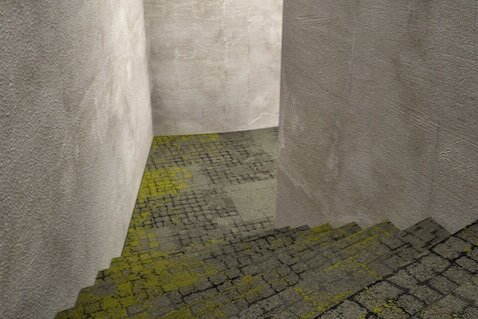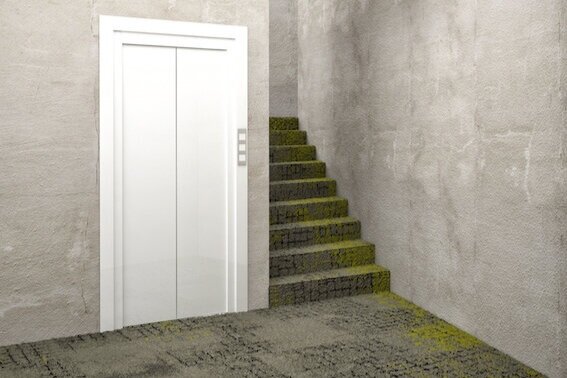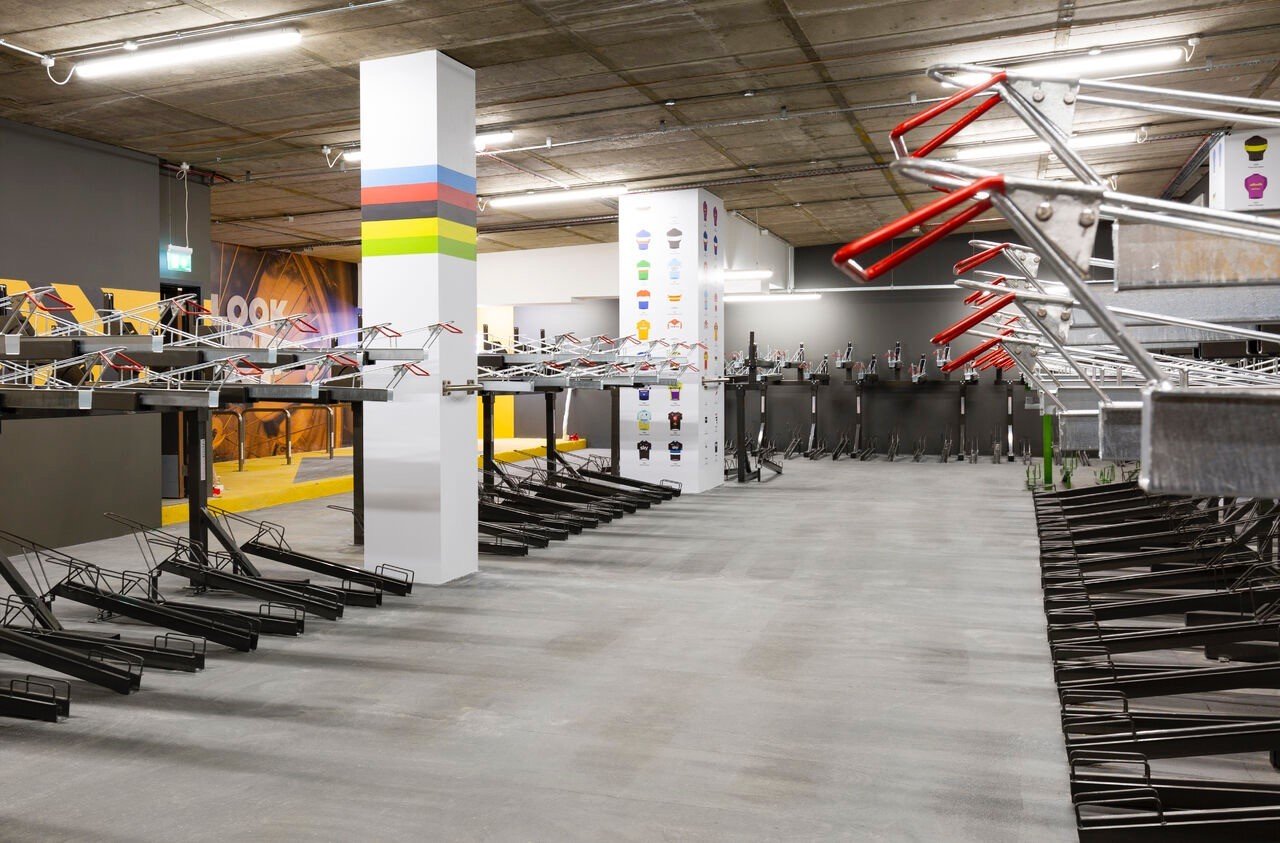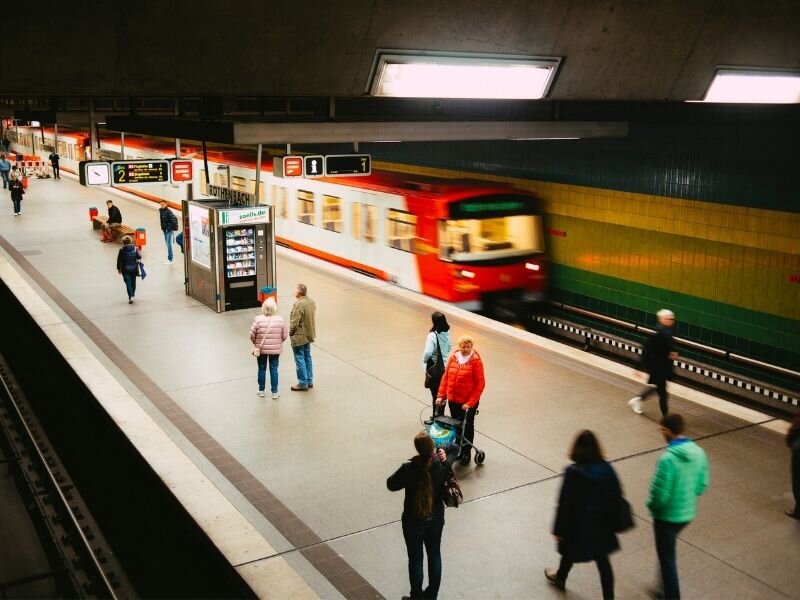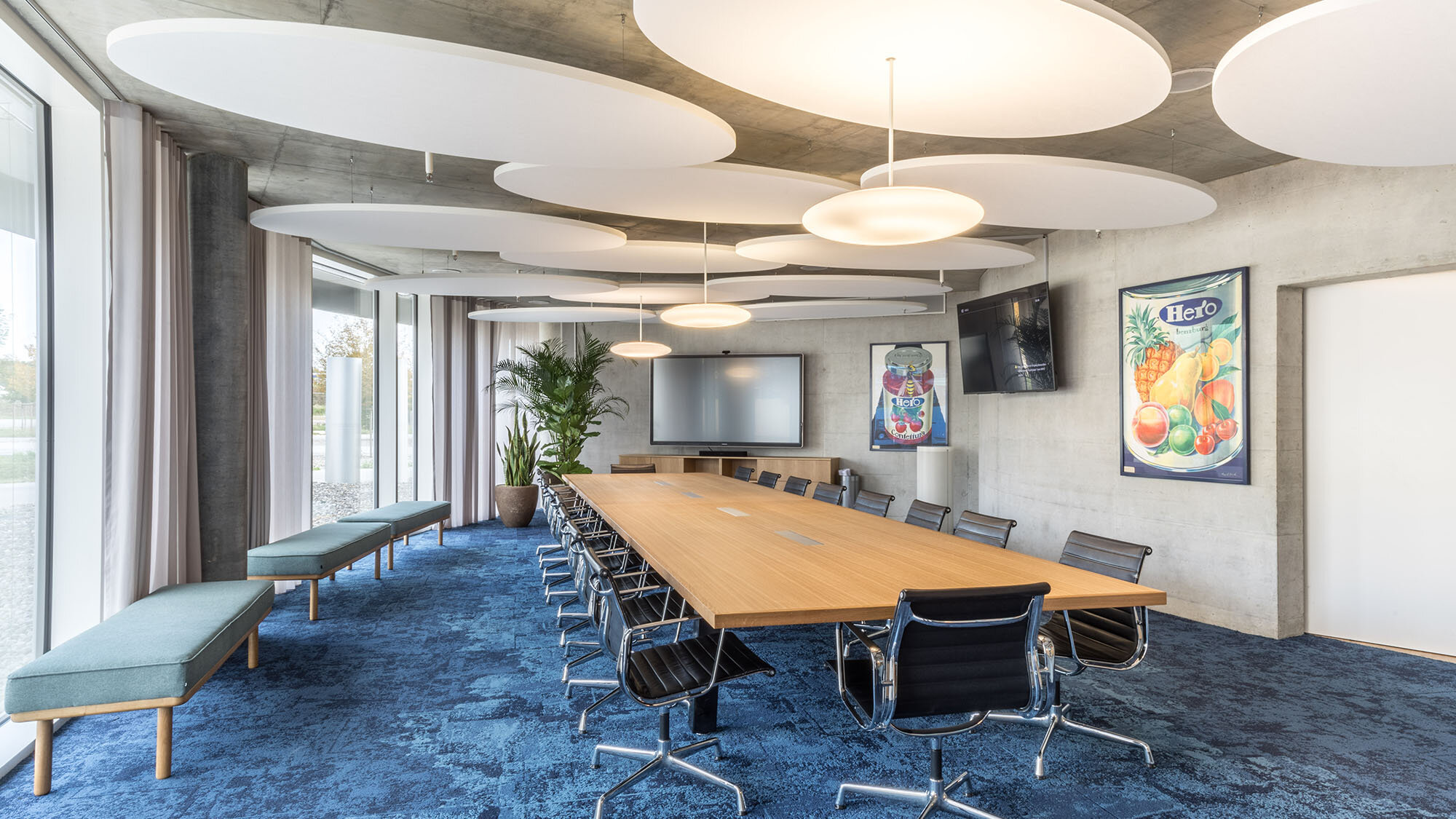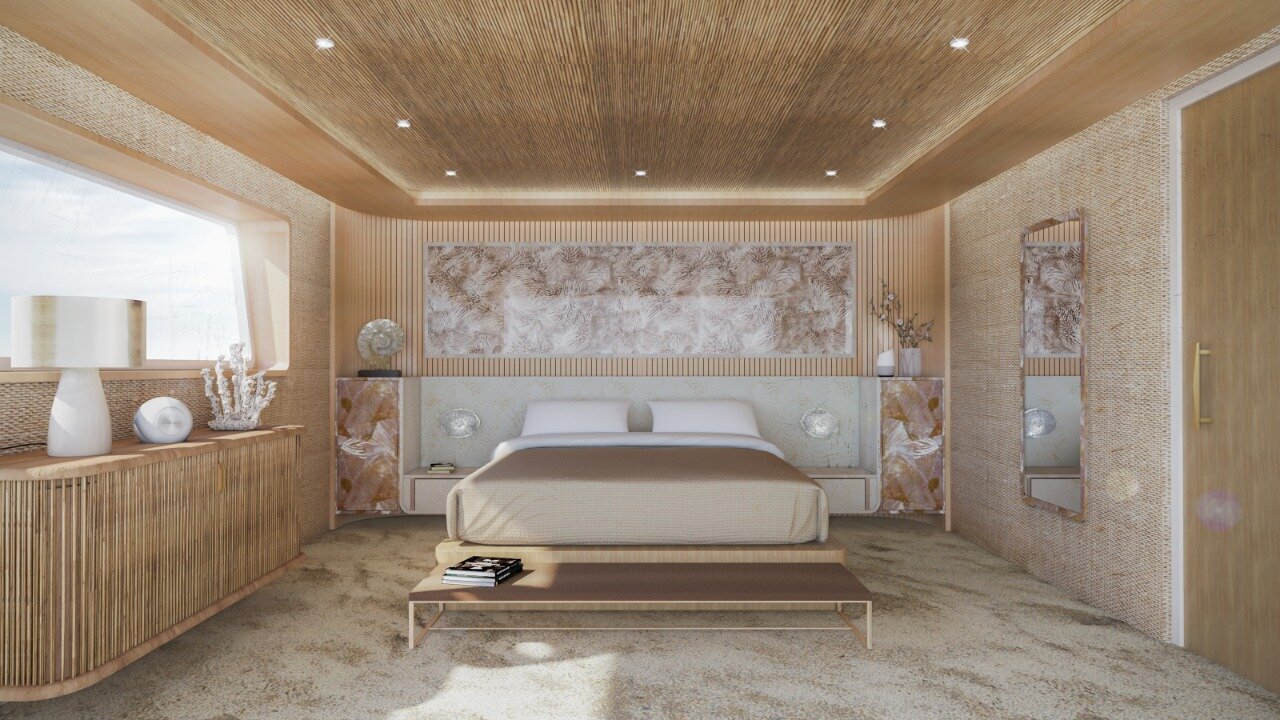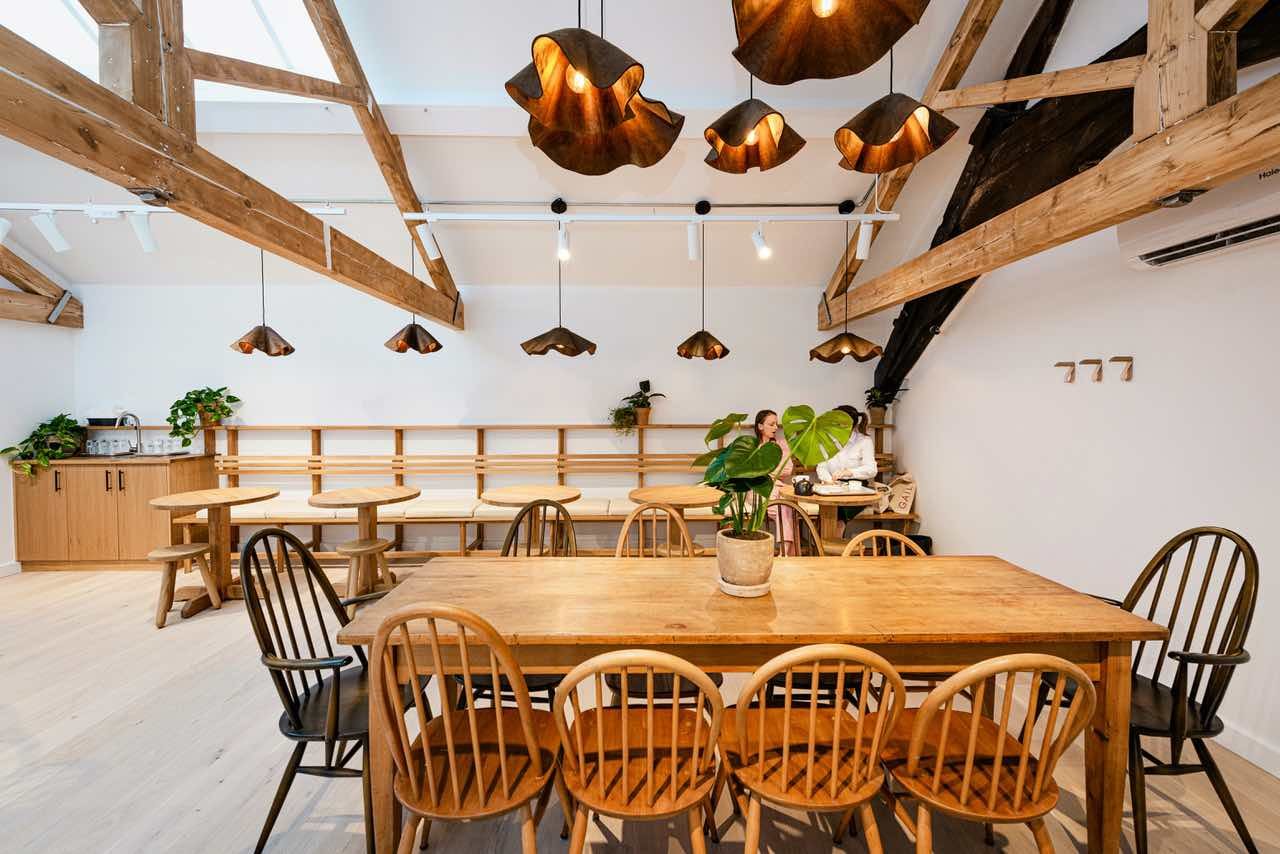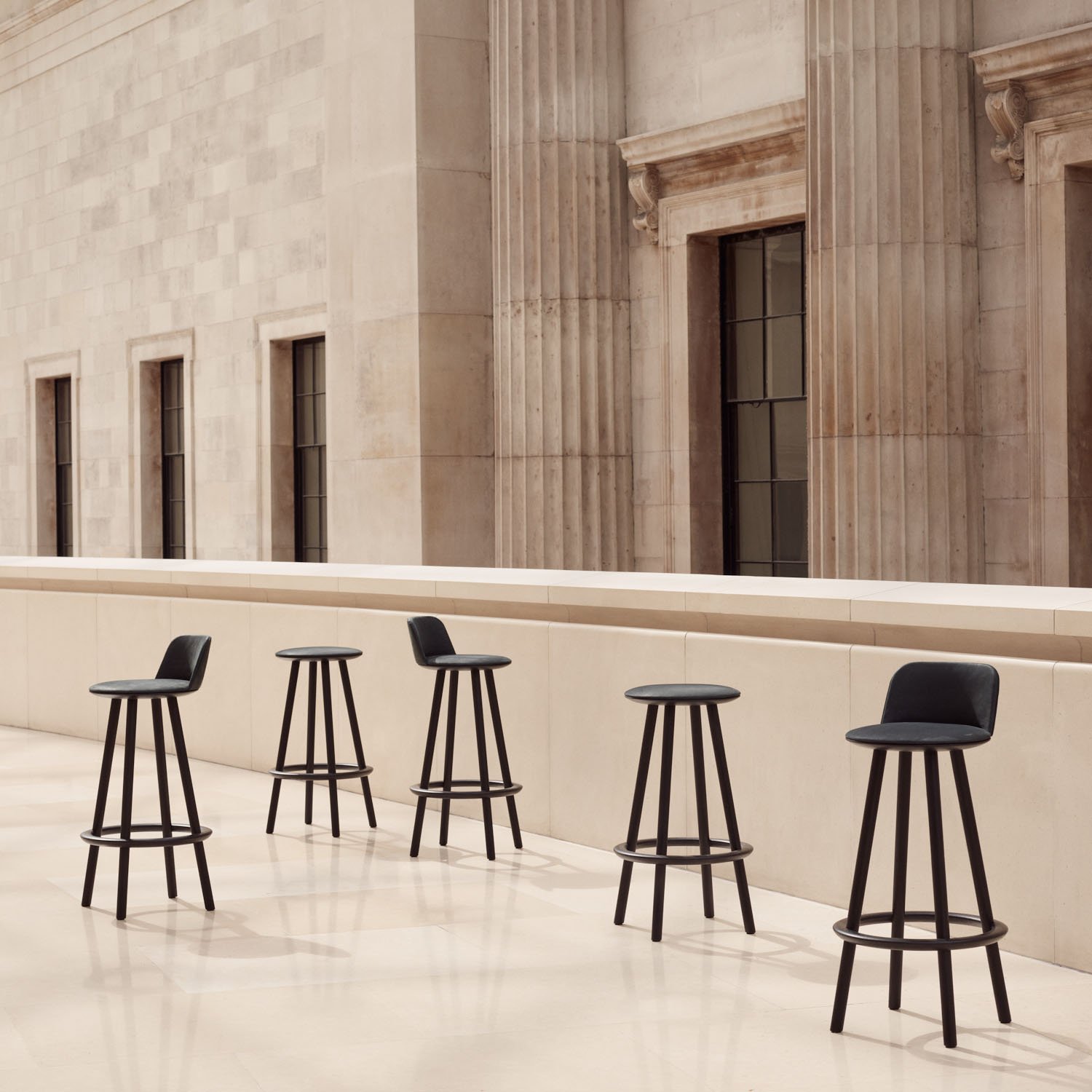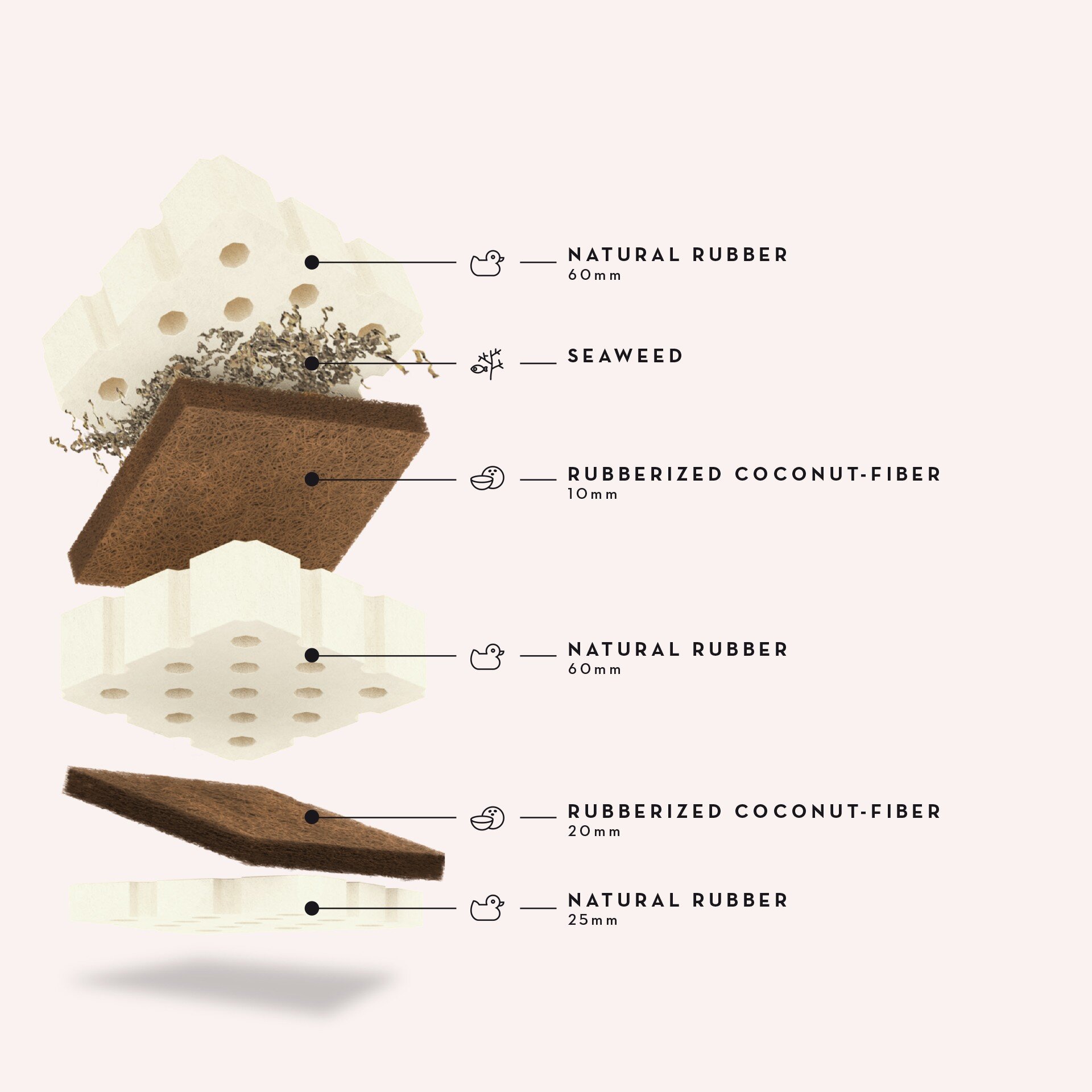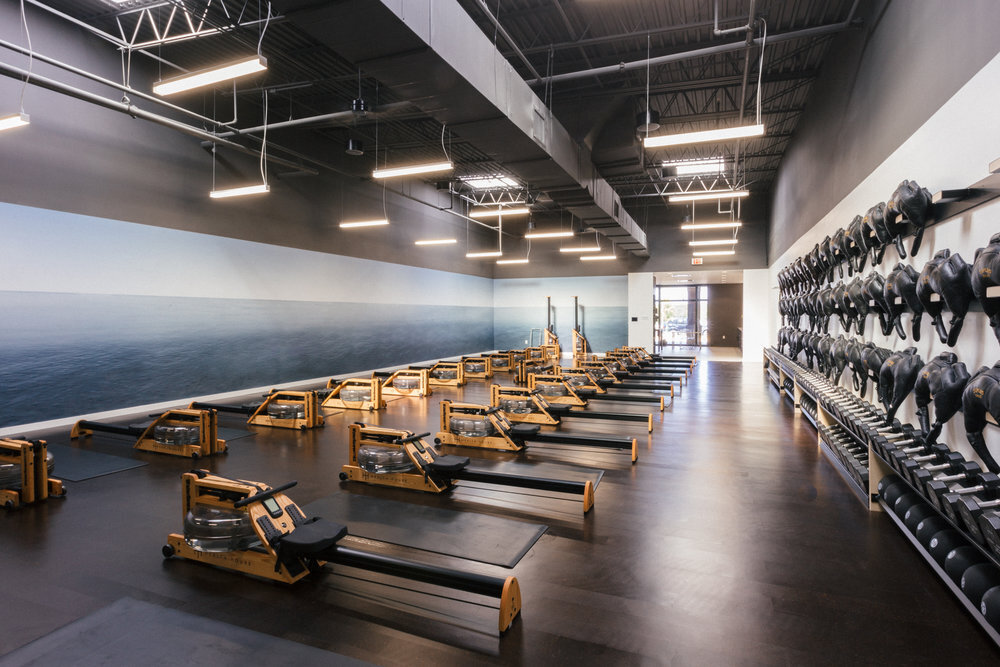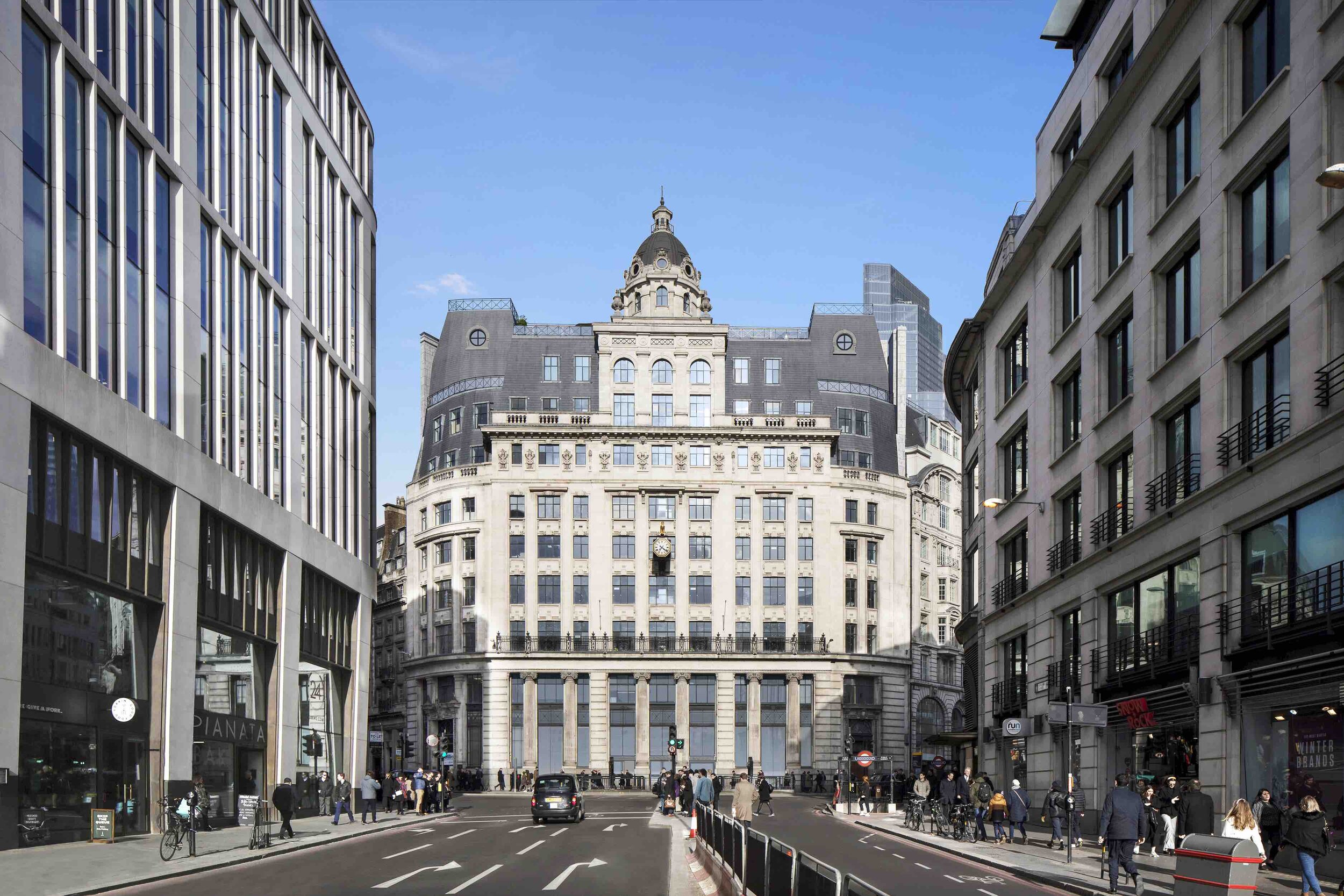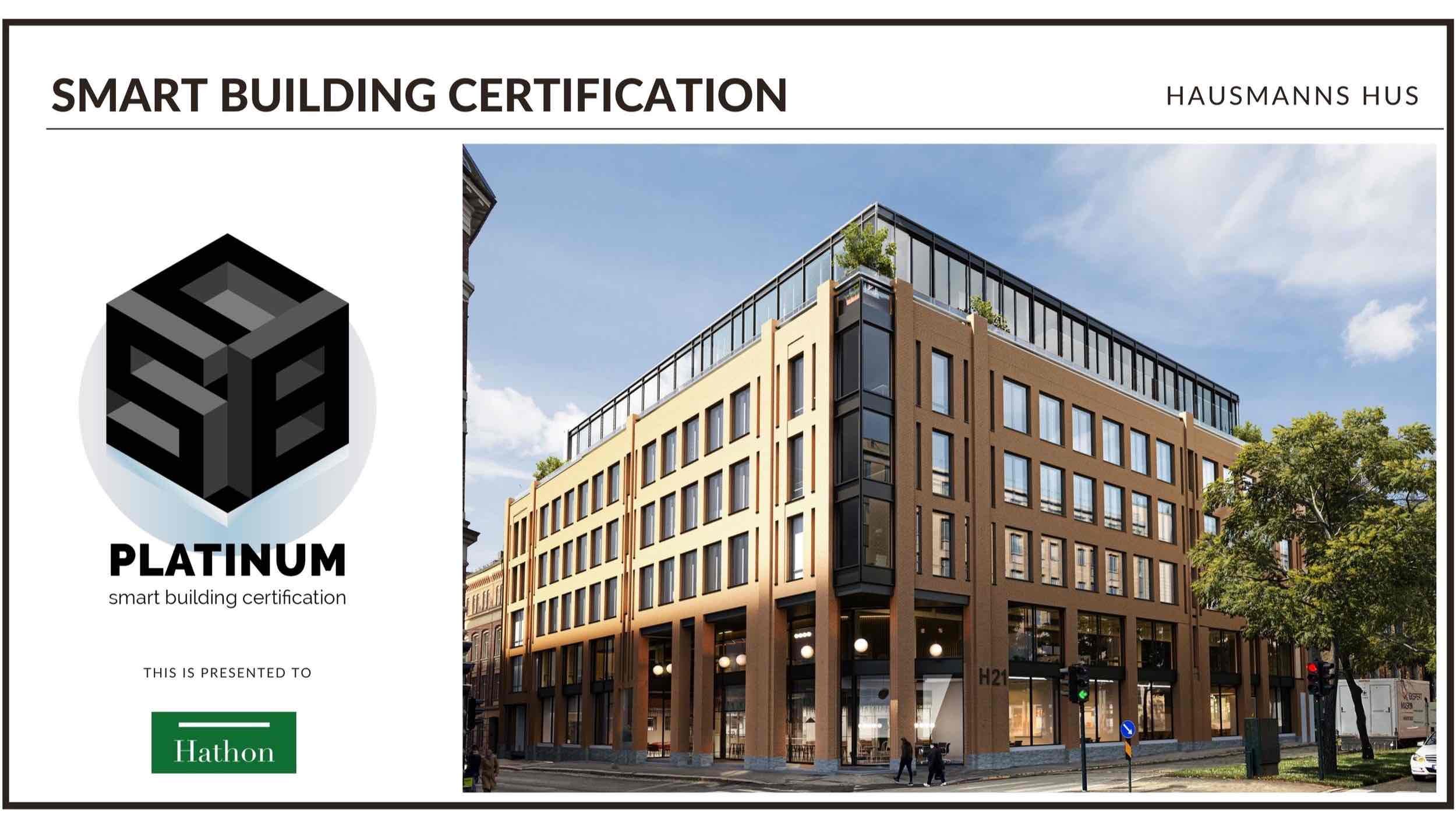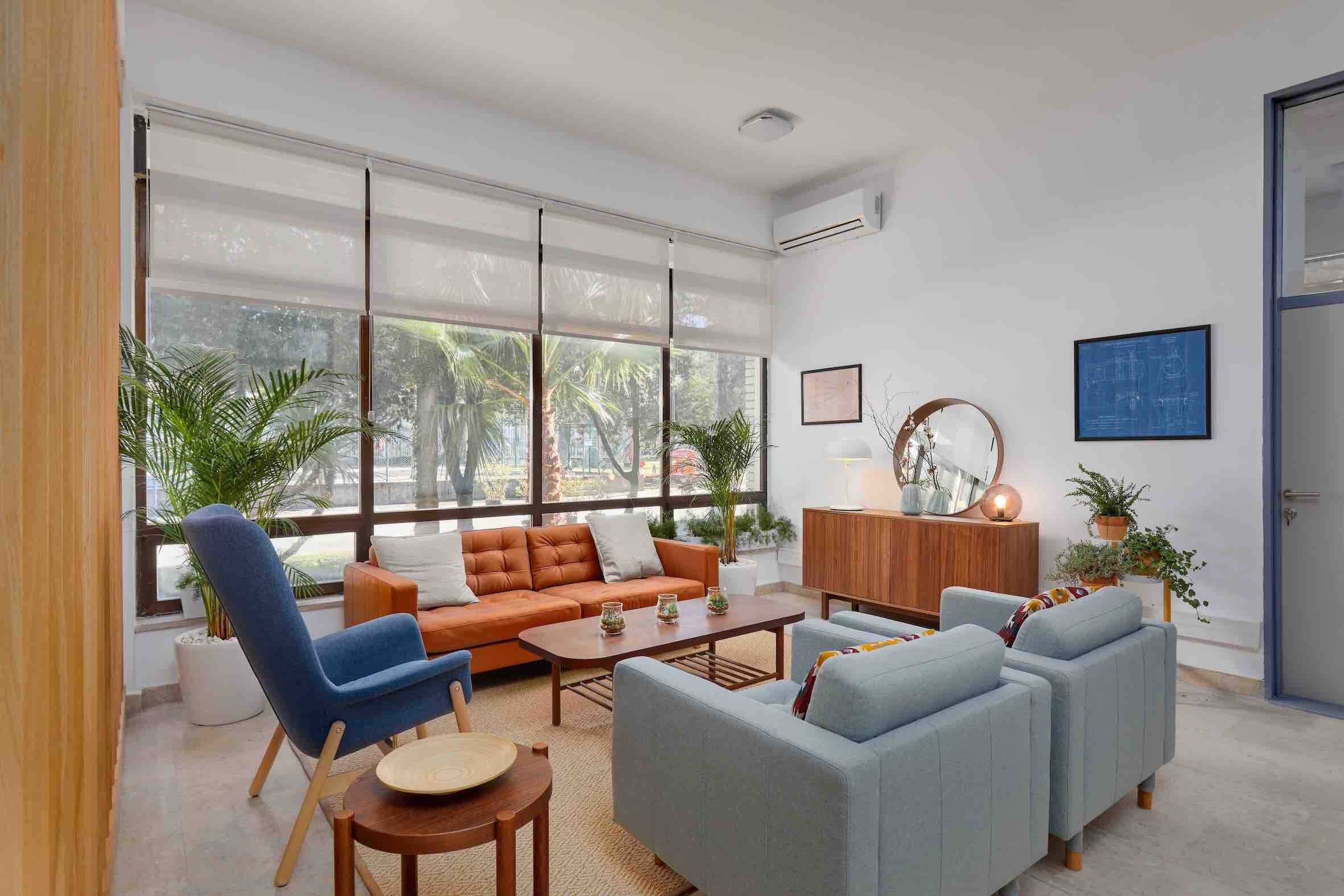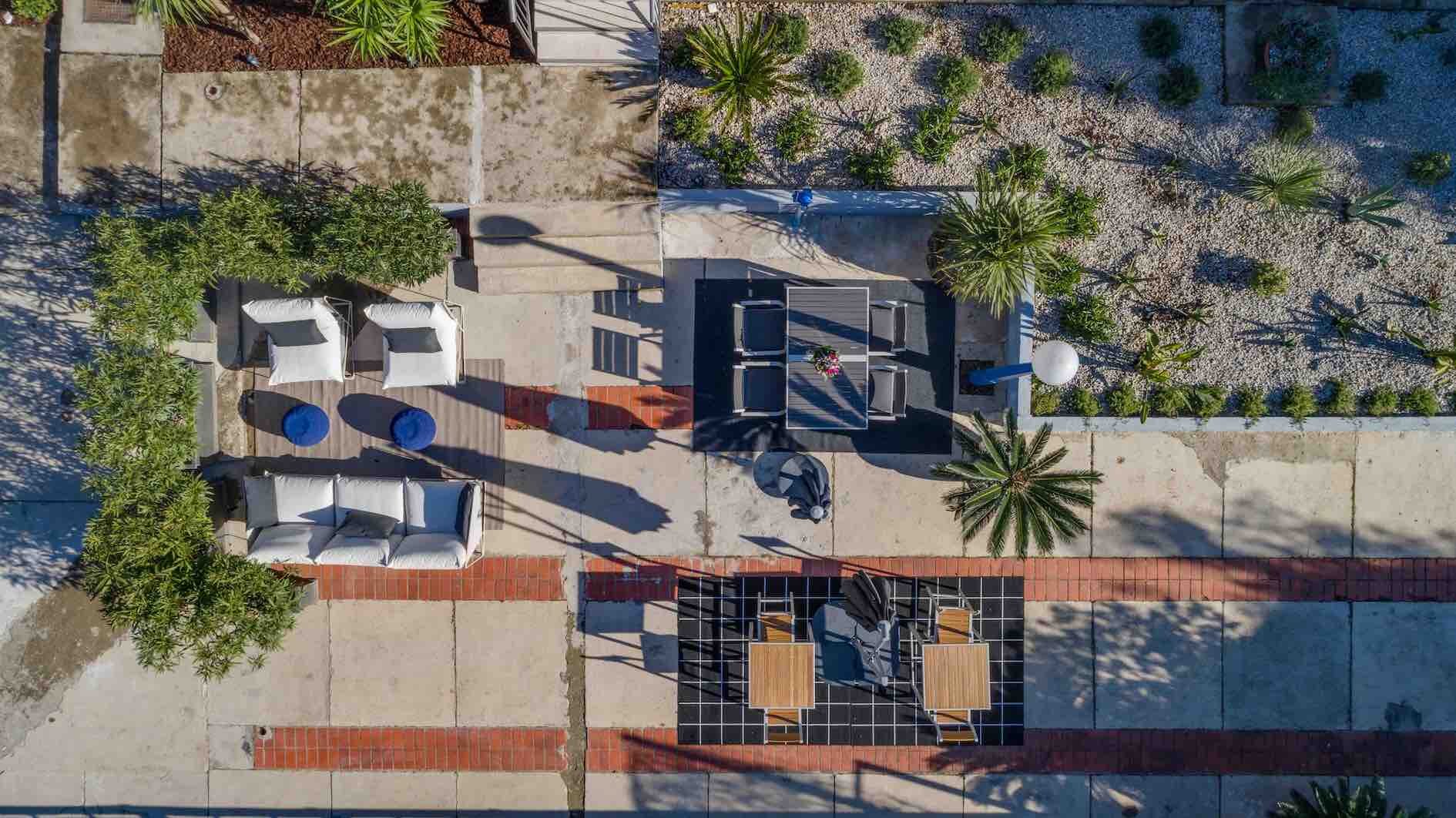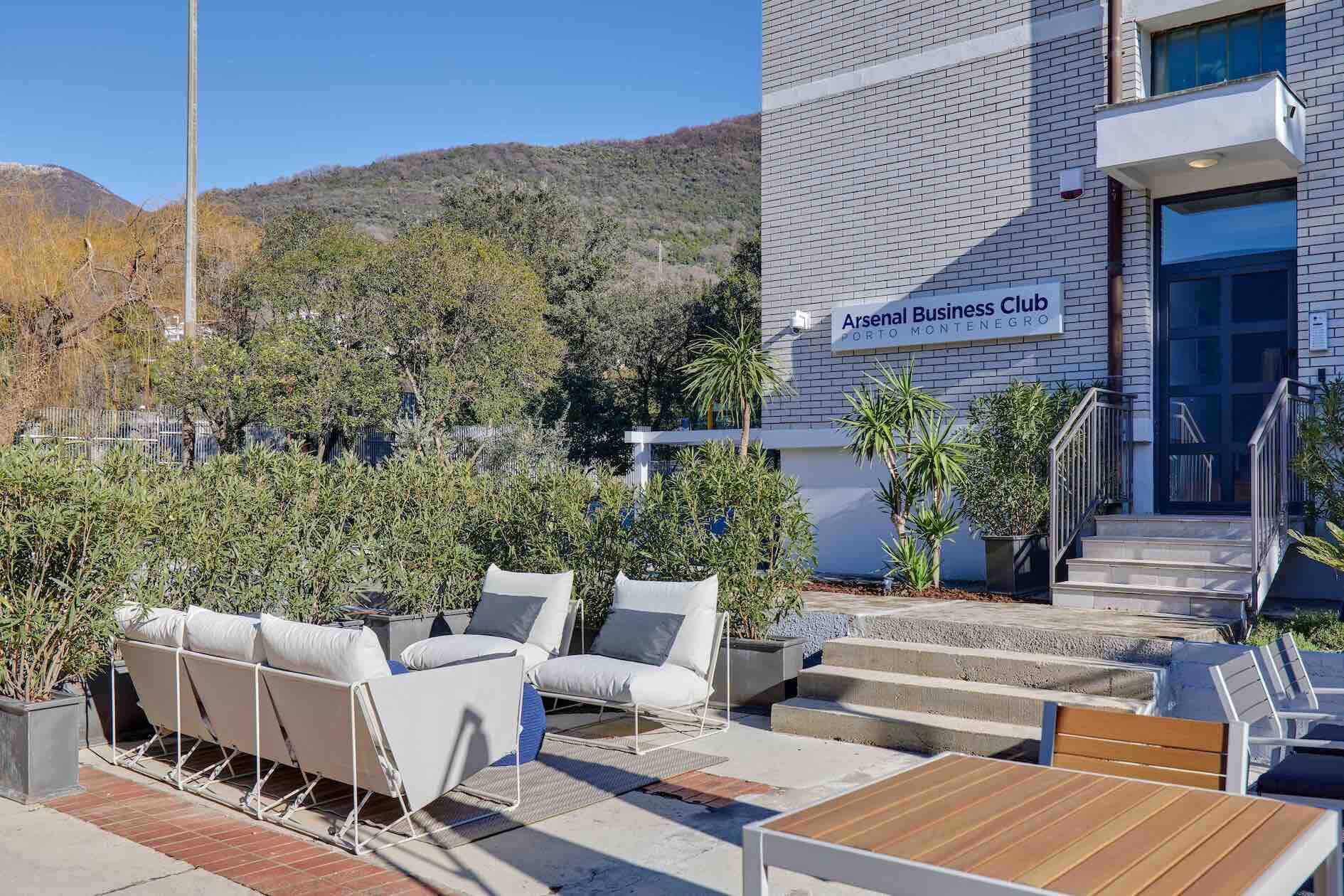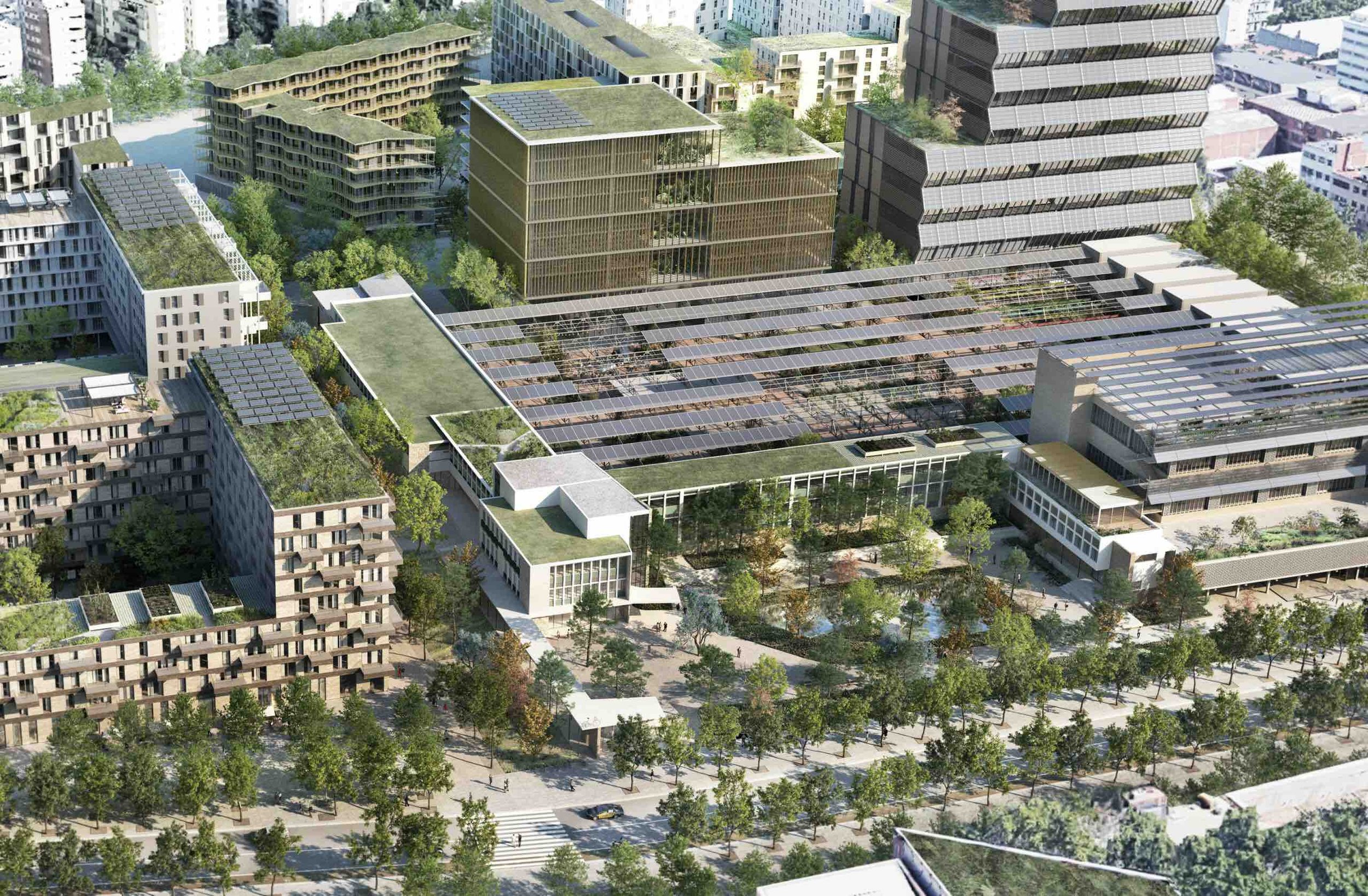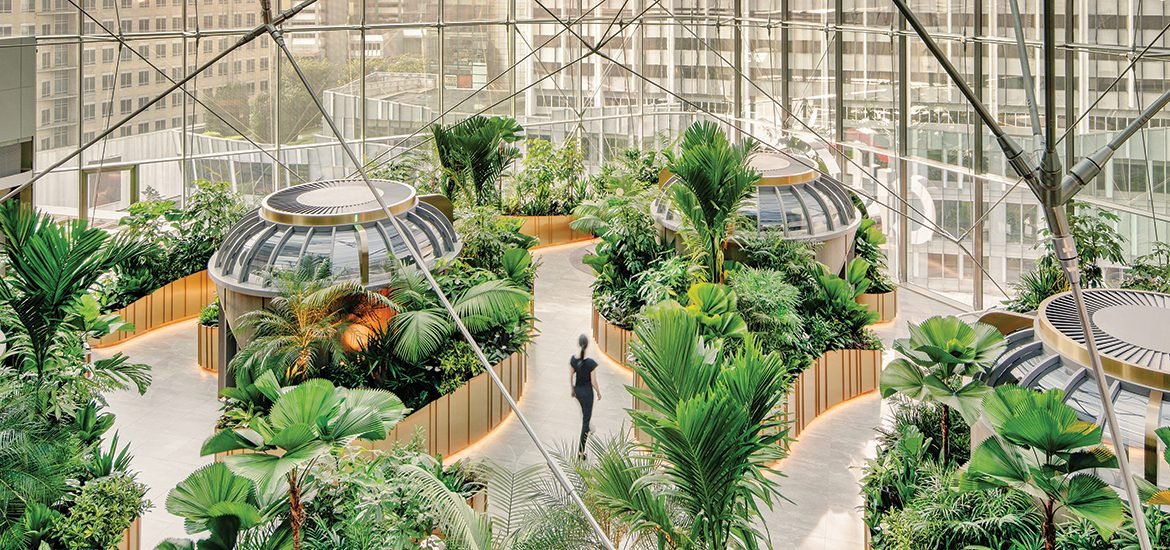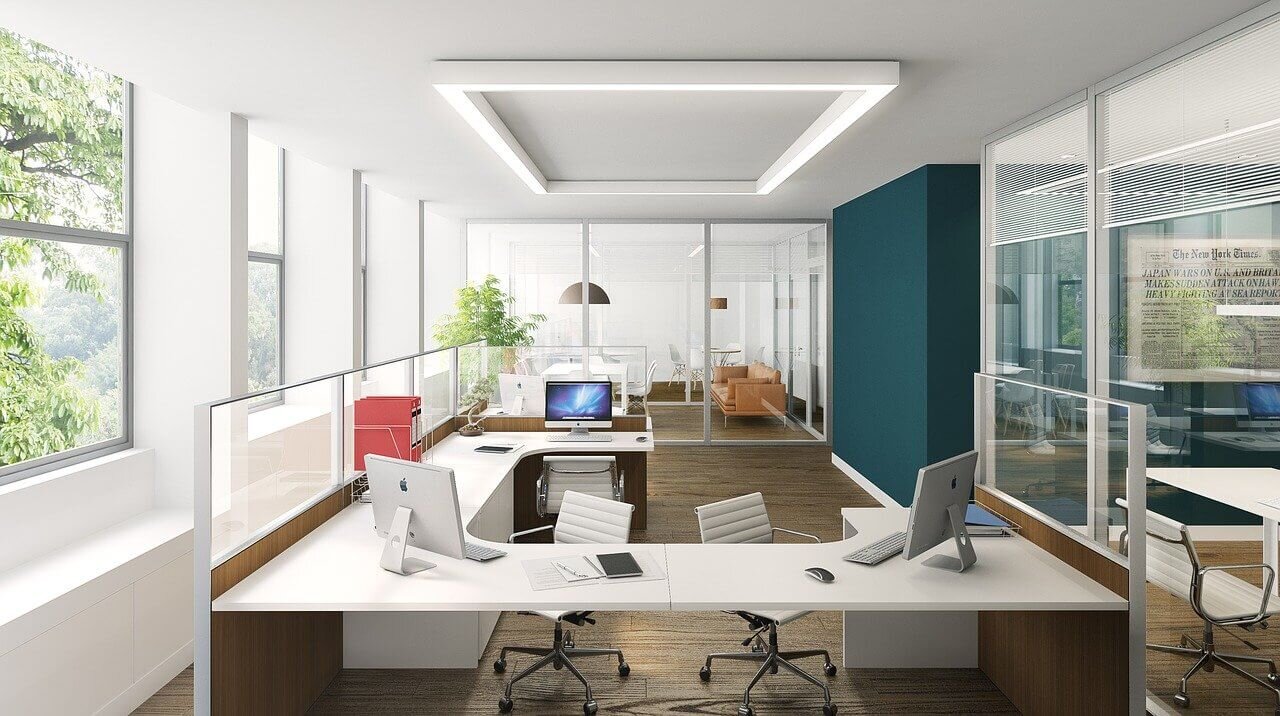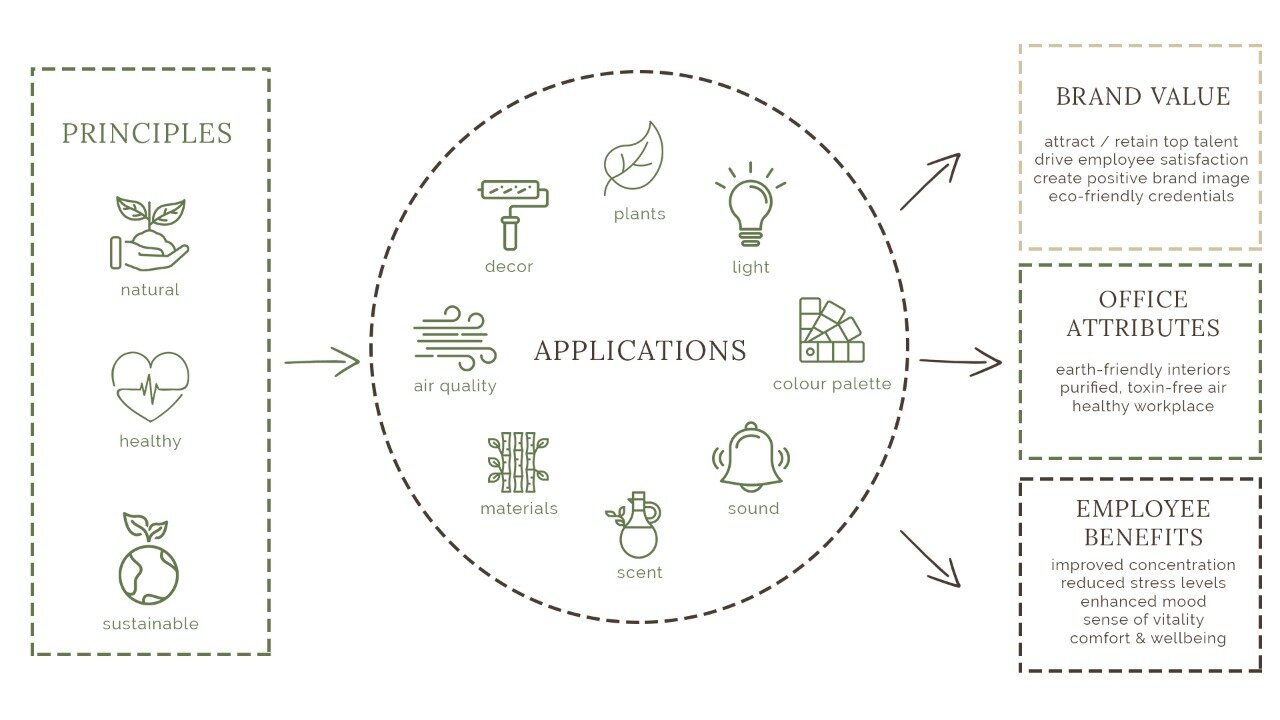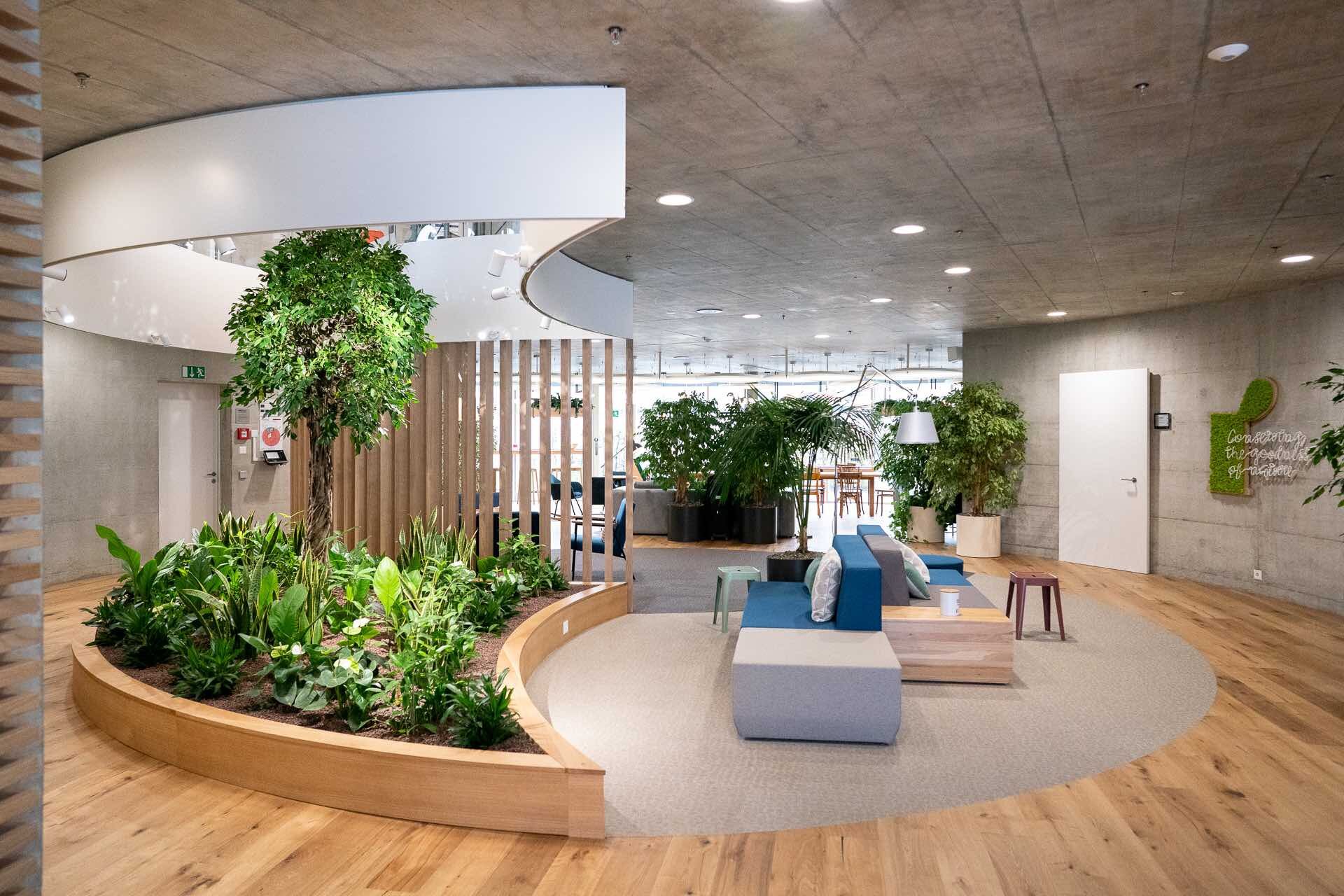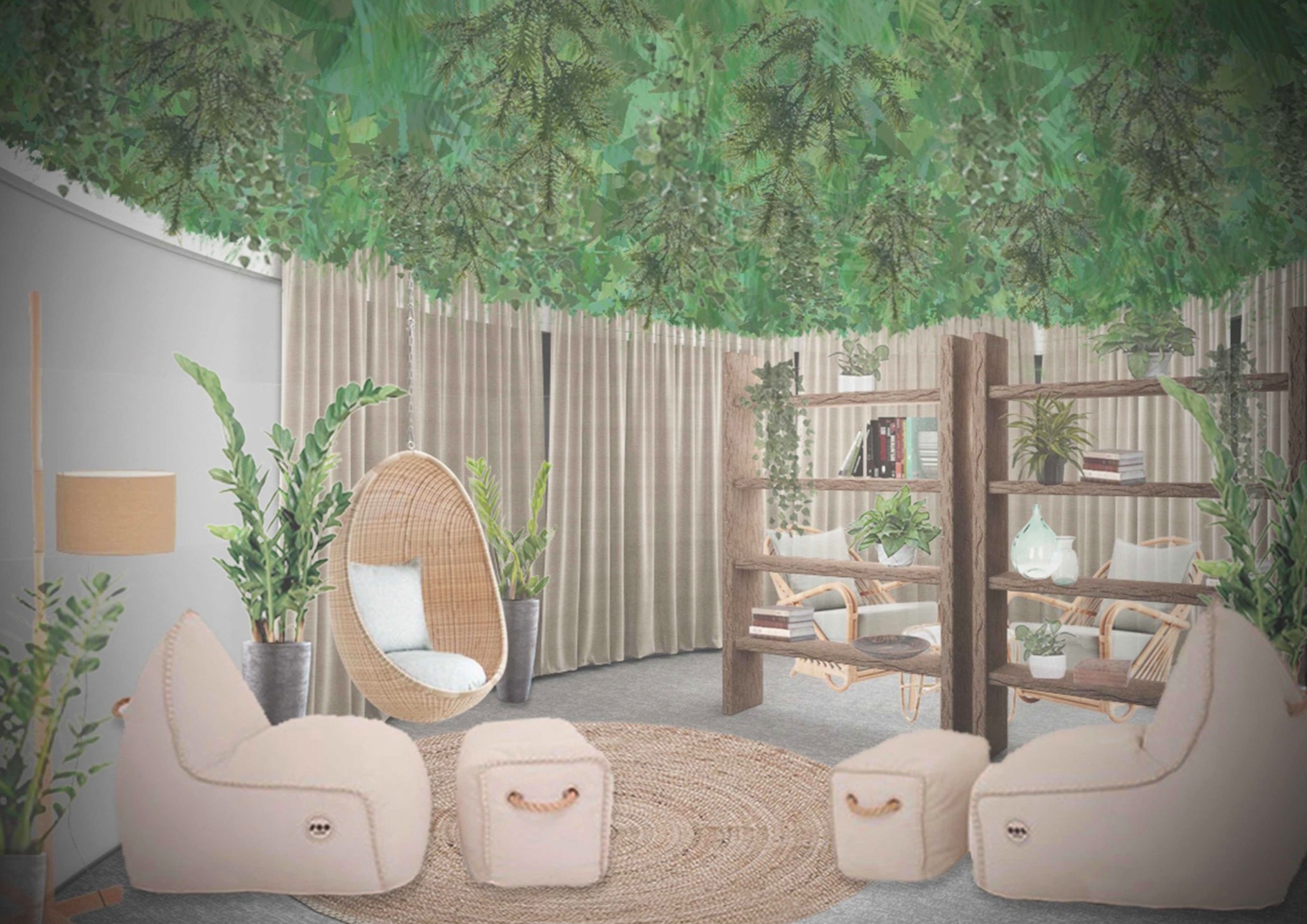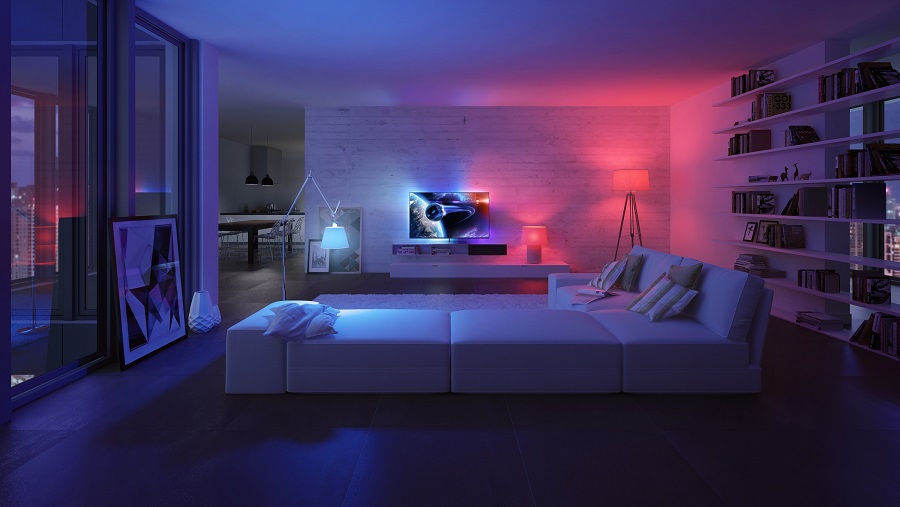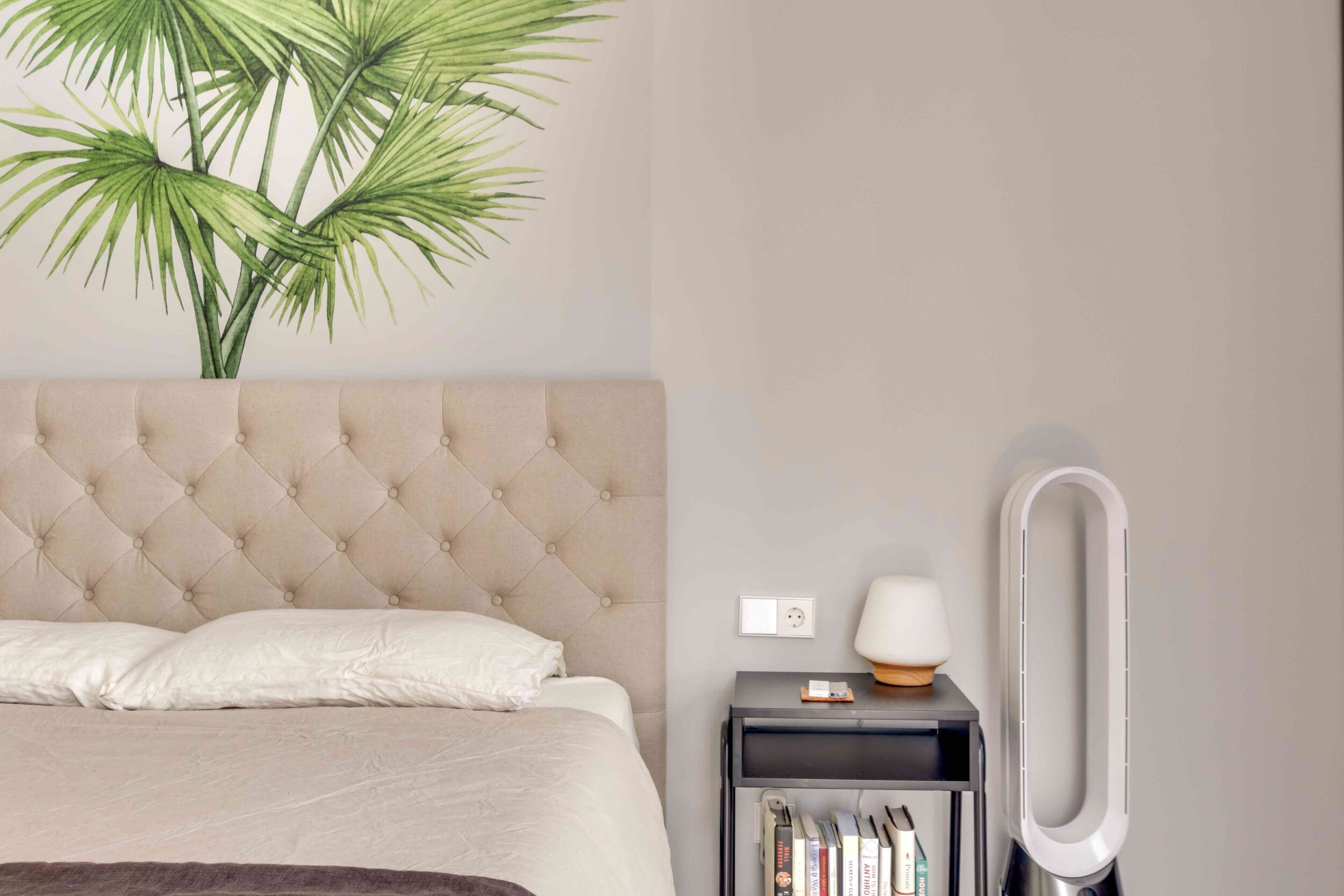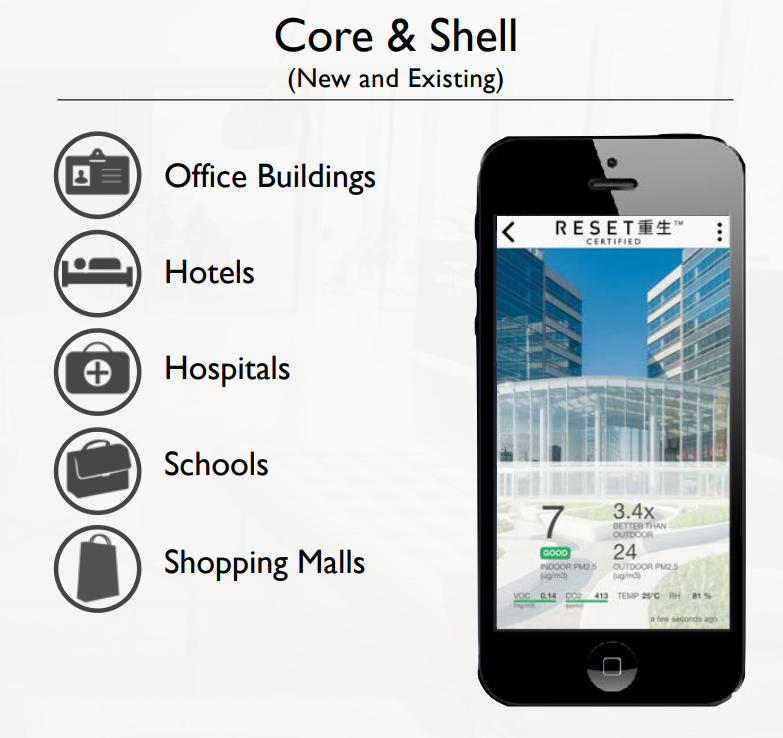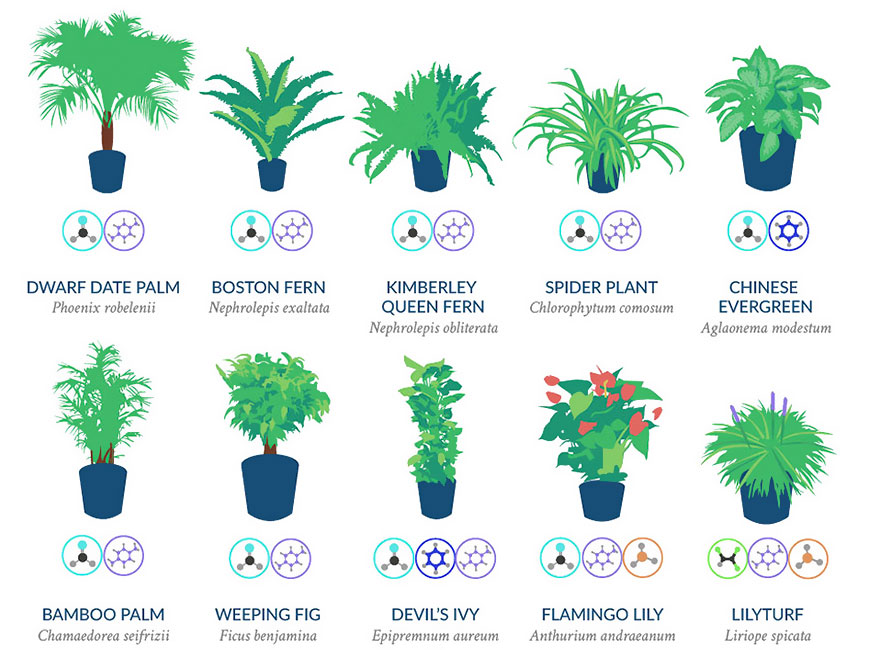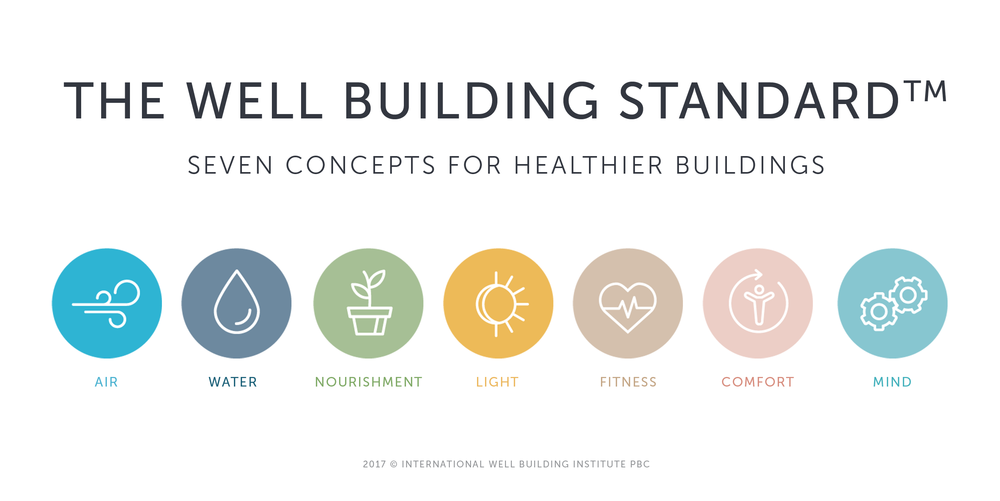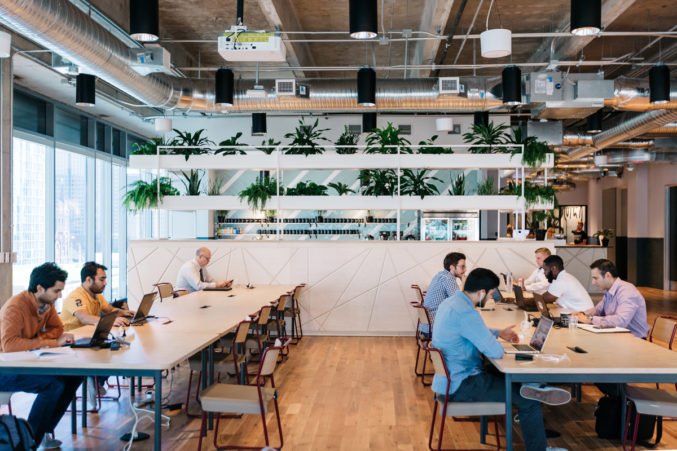Active Stairs: Well Building Standard Movement V03 — Biofilico Wellness Interiors
A consultant’s response to the WELL Building Standard Feature: Movement V03 / Circulation Network looking at how to create dynamic stairwells that encourage movement 'snacks' by regular occupants of the healthy building
A consultant's response to the WELL Building Standard Feature: Movement V03 / Circulation Network and Active Design Principles
What is the WELL Building Standard?
The WELL Certification process for WELL V2 is now widely established as the leading healthy building and wellness real estate standard in the world today. It is essentially a series of guidelines backed by rigorous scientific research, including active design principles and active design strategies, that when taken together, will guide a real estate project, whether new build construction or refurbishment and fit-out, towards a final product that is aligned with human health and wellness.
Sections of the V2 standard are dedicated to Air, Water, Nourishment, Light, Movement, Thermal Comfort, Sound, Materials, Mind, Community & Innovation.
What is WELL consulting?
A WELL AP or WELL consultant is there to assist a project team through the certification process, ensuring maximum points are scored along the way by offering expert advice not just on how to lock-in points but also the principles that lie behind them. Building owners play a crucial role in promoting physical activity through active design strategies. As a result, the project has every chance of becoming a model of health and wellness in the built environment.
Additionally, a WELL consultant’s skill set might include wellness interior design, knowledge in healthy buildings and consideration for sustainability / green buildings, a WELL building’s close cousin, as well as expertise in health and fitness, or as WELL like to call it ‘Physical Activity‘, ‘Movement‘ and ‘Nourishment’.
What healthy building issue is WELL Feature Movement V03 addressing to encourage physical activity?
In this feature of the WELL building certification we are dealing with, wait for it… staircases! As consultants specialising in the field of wellness real estate, we admit to getting quite excited about stairwells as they represent an often neglected corner of an office or residential building that in a sense has physical activity built into it, however far too often they are not decorated with anything beyond whitewash and basic directional signage.
A healthy building needs to switch its priorities to make the stairwells a feature that regular occupants want to use, even enjoy using. To do that, WELL encourages projects to think about aesthetics, visibility and signage prompts.
The underlying problem is, once again, physical inactivity and sedentary lifestyles. The solution is more movement during the work day and that means, amongst other things such as physical activity spaces and physical activity opportunities), climbing stairs more often and designing spaces that encourage physical activity.
Where did this WELL movement feature draw its inspiration?
The researchers went looking for ‘active design’ case studies from airports, healthcare facilities, universities and offices, all leading them to the conclusion that an enhanced stairwell experience combined with subtle but effective prompts nearby in the form of permanent signage, all have a tangible impact on overall movement and activity levels in the workplace. The concept of 'active living' and 'promoting physical activity' through architectural principles and urban design also served as inspiration for these strategies.
What do we mean by ‘enhanced aesthetics' in this WELL healthy building feature?
For us, this is about being creative with a minimal budget. The reality is that projects are unlikely to apply huge budget per floor, imagine a 10 story building for example, even at a 3,000 euro budget per floor that still adds up to 30,000 euro in total just for active design stairwells. So how do we recommend using what minimal budget is on offer?
Options include flooring, wall decor, lighting, plats or biophilia in general, music speakers even artworks or motivation vinyls on the walls. It’s about making the stairwells bright, visually pleasant and dynamic areas rather than cold, heartless corners of the building. Incorporating visually appealing stairs and feature stairs can significantly enhance the aesthetic appeal and promote physical activity.
Artworks need not be originals, prints will do here. Wall decor can be blocks of brightly coloured organic / low-VOC paint, or large format vinyls. Flooring needs to be extremely hard wearing for obvious reasons but it could be brightly coloured, or have a biophilia, nature-inspired pattern such as the one in our concept design above for a corporate headquarters with a healthy building objective in Switzerland. Bright and or coloured LED lighting can also bring life to a dark stairwell with no natural light.
If the option is available, a WELL AP should lobby the master-planners and architects on a new build construction project to position stairwells in a location that makes them visible and easily accessible to all regular building occupants. It’s all about an active design approach, placing stairs not as a Plan B but as a preferred option, or Plan A,… within reason!
WELL / movement V03 / Part 1: Design Visually Appealing Stairs (1 point)
There is no limit to how far this creativity can be pushed clearly but in terms of securing a point for this WELL healthy building feature, the certification standard is looking for at****least one staircase with a minimum of two****features from the list below on each floor. Central stairs and those in educational and auditorium spaces are prime examples of where these design elements can be applied:
Music
Artwork
Light levels of at least 215 lux when in use
Windows or skylights that provide access to daylight
Natural design elements (e.g., plants, water features, images of nature)
Gamification
WELL / movement V03 / part 2: signage prompts (1 point)
This is where a WELL AP and consultant team need to align with the signage consultants, or indeed take ownership of this element of the overall signage plan whilst integrating the design and production with the rest of the project's signage style.
At least on staircase servicing all floors needs point-of-decision signage near the main entrance or reception desk , at the elevator or escalators, and at the base / entry points of the stairs. The objective here is to grab the attention of building users just before they commit to taking the elevator or escalator instead of taking the stairs.
We want to nudge them in the direction of the stairs, this could be done in a very simple, neutral tone or indeed with something more playful that challenges the users to ‘burn some extra calories while you work', or ‘hit those quads and hams', as long the messaging is positive, not negative.
Finally, additional wayfinding signage may be required if the stairs are not visible from the location of the signage prompts, to ensure users do not get lost and change their mind!
WELL / movement V03 / part 3: promote visible stairs for improved employee health (1 point)
As a WELL consultant, we find this to can be a challenging point to win, as it requires at least one staircase servicing all floors that is open to regular occupants of the healthy building and located before elevators or escalators.
Why is this a challenge? Quite simply because we are rubbing up against the requirements or the building engineers and architects, so ‘active design’ requirements often have to take a back seat. Additionally, considerations such as building codes and mental health must be factored into the design of visible stairs. That said, the point is there for the taking if the project’s stairs happens to fit within these requirements.
If you are interested in our services helping you create active design stairwells on your real estate project for WELL Movement V03,contact us here.
wellness flooring & paints in interior design
Examples of healthy flooring, wellness flooring & non-VOC, non-toxic wall paints in interior design
Examples of healthy materials for flooring, wall paint and curtains to create a wellness interior concept
What role does flooring play in a healthy interior?
Flooring is one of the key product categories in this healthy interior trend, for obvious reasons. Western cultures, unlike say Russia or Japan, typically have less strict social rules around wearing outdoor shoes indoors, meaning dirt and bacteria from the streets have an easier time making their way into a residential carpet for example.
For more on this subject see our dedicated page here.
Air-purifying carpets?
The Desso Airmaster carpet tile by US giant Tarkett is a perfect example of what is happening in the commercial office market today in terms of air-purifying flooring. Why office interiors and not say gym flooring, hotel flooring or yacht interiors you may well ask?
Offices are primarily places of work, staff are first and foremost there to be productive and staffing costs are invariably a business's largest overhead, therefore anything that can move the needle of productivity, even if by just 3-5% for example, represents a tangible value-add for corporations, well worth a corporate HQ carpet upgrade in other words!
Sustainability first, health benefits second
Importantly, the Airmaster is first and foremost a sustainably made product with a highly respectable Cradle to Cradle certification and an EcoBase backing as standard. In terms of its functional benefits to users, it captures and retains fine dust particles, in some tests proving to be up to 20 times more effective than smooth flooring solutions. This makes it especially relevant for allergy sufferers.
Finally, it has low Volatile Organic Compound (VOC) emission properties with minimal PM10 particles - despite the name 'organic', VOCs are the bad guys as they are mildly toxic. Taken together, this makes the Desso Airmaster a viable contender for a yacht refit carpet option.
Toxin-free flooring
Milliken's Breathe range of flooring is GreenGuard certified for its low chemical emissions, made of natural or recycled fibres from plastic bottles and has a plant-based water repellency component that is fluorine-free.
Milliken have ensured that the carpet is completely VOC-free. We'd love to see the Breathe range deployed in a yacht interior for just these reasons.
Anti-bacterial & eco-friendly floors or walls
Active Surfaces by the Iris Ceramica Group in Italy go perhaps one step further with their ceramic porcelain wall or flooring tiles that come packed with anti-bacterial, anti-viral, anti-pollution and anti-odour properties.
To achieve this, natural or artificial (e.g. LED) light and humidity present in the air contribute to eliminating 99.99% of bacteria and contagious viruses that settle on the tiles.
What's more, these ceramic tiles are 100% recyclable and most are produced with more than 40% recycled content in zero emission factories. The tiles are certified by ISO 10678, ISO 27447 and ISO 27448.
Indoor paints with air-purifying qualities
Healthy wall paints are another high-growth sector we have our eye on, with brands such as Gush from Singapore bringing out a product called Cair that actively attacks airborne pollutants with catalytic reactions that break down VOCs such as formaldehyde and odours into harmless by-products such as H20 and O2.
It is anti-moulding, making it suitable for bathrooms or spa rooms, as well as anti-bacterial - in other words it eliminates 99.9% of infection-causing bacteria such as E. Coli, according to Gair.
Gush focus on a purely residential market with an at present limited product range while, closer to home here in Europe, Airlite from Italy have more products on the market already and offer indoor, outdoor and primer solutions, giving them more of an in-road into the architectural and industrial paint sectors.
Again here, the paint claims anti-bacterial, anti-mould and anti-odour properties. Airlite products are also non-toxin, VOC-free, some have air cleaning properties and are produced using 100% renewable energy.
Healthy materials for curtains
Swiss company HeiQ has produced a curtain fabric that IKEA has bought for wide-spread distribution throughout its network under the product name 'Gunrid'. The HeiQ Fresh AIR is a mineral-based technology uses transmitted ultraviolet (UVA) light from the sun to convert VOCs into harmless CO2 and O2, just like the Gush Cair mentioned above.
contact us to discuss your interior consultancy requirements
Healthy materials in sustainable interiors
We use healthy materials in our wellness interiors to balance sustainable interior design concepts with concerns for indoor air quality, biophilia, aesthetics and durability.
What are healthy materials vs sustainable materials? How can buildings and interiors integrate circular materials to reduce environmental impact?
We advise teams on the selection of materials for real estate development and interiors projects, typically as part of a wider sustainability plan or ESG strategy for example. Contact us to find out more.
What are healthy materials?
A number of innovative products and materials now exist in the marketplace that promise added wellness benefits, be it in a home, office or hotel. This is in a sense an evolution of a previous shift towards sustainable, natural materials.
The Covid crisis has only served to bring all of this into the mainstream public's attention as there is now a far greater appreciation of hygiene and the concept of Indoor Air Quality (IAQ) nowadays, especially with the rise of the Well Building Standard.
sustainable interior flooring Zandur
Our podcast conversation with Robert McKee, the dynamic founder of Zandur sustainable flooring based in Virginia, USA that supplies hospitals, offices, gyms and residential spaces around the world.
The ‘Green & Healthy Places’ podcast series takes a deep-dive into the role of sustainability, wellbeing and community in real estate and hospitality.
Here we discuss sustainable interior flooring with Robert McKee of Zandur in the USA.
Sustainable interiors & healthy flooring material
Welcome to episode 15 of the Green & Healthy Places podcast in which we discuss sustainability and wellness in real estate and hospitality. This episode we’re with Robert McKee, the dynamic founder of Zandur sustainable flooring based in Virginia, USA that supplies hospitals, offices, gyms and residential spaces around the world.
Designing a healthy indoor environment
Flooring plays a fundamental part in creating a healthy indoor environment, particularly indoor air quality, now more than ever designers and architects need to be thinking about cleaning and hygiene, which is where Zandur comes in…
Robert talks us through the world of healthy product certifications, the many benefits of using cork as a raw material, why you do NOT want natural rubber in your floor covering but rather vulcanized rubber, the life cycle of flooring and the role of maintenance over a possible 30 years, as well as Zandur’s innovative approach to design that draws inspiration from craftsmen of the early 1900’s.
If you like this type of content please consider subscribing and you can of course find Zandur USA or a local distributor at zandur.com
GUEST: ROBERT MCKEE / Founder, Zandur / www.zandur.com
HOST: MATT MORLEY / www.biofilico. com / www.biofit.io / www.bioblu.org
——————————-
A full transcription follows, courtesy of Otter.ai:
Matt Morley
Welcome to Episode 15 of the Green and Healthy Places podcast, in which we discuss sustainability and wellness in real estate and hospitality. I'm your host, Matt Morley, founder of BioBlu sustainability, Biofilico wellness interiors and Biofit nature gyms.
This episode, we're with Robert McKee, the dynamic founder of Zandur sustainable flooring based in Virginia, USA, supplying hospitals, offices, gyms, and residential spaces around the world. Flooring plays a fundamental part in creating a healthy indoor environment, particularly as it relates to indoor air quality. Now more than ever, designers and architects are thinking about cleaning and hygiene, which is right in Sandur's ballpark.
Robert talks us through the world of healthy product certifications, the many benefits of using cork as a raw material, why you do not want natural rubber in your floor covering but rather vulcanised rubber, the lifecycle of flooring and the role of maintenance over what can be 30 years, as well as Zandur's really innovative approach to design that draws on inspiration often from craftsmen in the early 1900s. If you like this type of content, please consider subscribing. And you can of course find Zandur and the local distributors listed on their website zandur.com
—————————-
Robert, thank you so much for joining us today. You founded the company back in 2004. Could you give us quick introduction to what Zandur flooring looks like today as a business, your products and, so on?
Robert McKee
Well, sure, and I appreciate it, thank you for taking the time to speak with me. A little bit about the company, we did start in 2004. The objective from the beginning has always been to focus on sustainable commercial products, the floor covering portion of construction and really with a focus of not selling something sustainable products that really perform or outperformed other products in the industry that weren't necessarily sustainable, and also meeting those same price points.
Our interest has never been to profit off of sustainability. It's always just to be sustainable. Because it's the right thing to do. And my family history goes back into the cork industry - cork flooring in fact. Sustainability was not something that people even talked about, you know, back in my grandfather's era. But it's always been something that we have had in our product line. And everything we've sold has had that sustainability story before it became popular. So it's something we just continue with.
Matt Morley
I think that really comes through in your current communications online that it is a fundamental piece of what you do rather than an afterthought that you've sort of tacked on at the end. It looks like you've built the business around that philosophy or that it's just it's just part of how you see the world, I think that there is a clear difference now in companies that really have a deep value system behind them like yours and that was very much the initial insight that led me to contacting you. I came across you primarily from the sport and fitness flooring and cork flooring, but you do others you do commercial flooring as well. Right?
Robert McKee
Correct. So basically just getting back real quick to what what you've mentioned and kind of where we come from, there's a lot of temptation always for companies to go out and sell products just to sell products, for instance, you know, we have plenty of opportunities to go and sell vinyl based products, things of that nature. And it's something from the beginning we've always made the point of focusing on sustainability. We're not going to enter into having non-sustainable products, competing with the big guys, yes they do have their sustainable lines but also their non sustainable lines. And to me it kind of defeats the whole purpose, either we're all in on sustainability or we're not.
But getting back to the products that we have. The first flagship product is something that we introduced way back when, it's a product made of cork and rubber combined. We've just recently made some significant improvements to that, it has great cleanability, which is obviously really important these days, chemical resistance, slip resistance, all those sorts of things. Then we have our solid rubber product, which is kind of the go-to heavy duty type of floor covering product for hospitals, airports, things of that nature. And then we have our solid cork flooring product, which has certain applications in commercial use, as well as a lot of residential use as well.
Matt Morley
So then, from an architect or an interior designer or design and build team perspective, how do they select one of these different materials and what that sort of pros and cons do they each have? I know you big on healthy product declaration certifications, right? The idea of a Declare label, from the the International Living future Institute and the Red List.
Robert McKee
So we've always been completely transparent about our products. Again, it goes back to the history of my family being involved in this business. It's just kind of how we're wired. And you can see that we participate in is these transparency programmes. The challenge is the cost for a small company, which can be a certain barrier to entry, whether intentional or not, so we try to pick and choose what's going to be most important, what's really going to tell the story about our product to the clients because ultimately, that's what we're trying to do - easily convey the sustainability story of our product in a completely honest way. That's what everyone else is looking for too. It gets pretty challenging, I think both on the supply side, and the specifications side, for people to really understand even what they're looking at. And I find that with designers or architects that have been doing this for a long time, even they get confused sometimes.
Matt Morley
Yeah, I think we end up we were looking for a quick and reliable route through in terms of digesting that information. And often Yeah, I can declare label or a cradle to cradle certificate, it's just but you know, once that's there, because of the integrity behind those systems, when a when a product comes out with that you can just rely on it. 100% I think that's they're going to be increasingly important. I think as, as the green building systems above start to require those individual product, green building products to align with their systems, because then you sort of you need everything to join up quite a bit like a Tetris puzzle. One of the things I wanted to ask you about was, and it's a big theme right now, for obvious reasons - indoor air quality.
Robert McKee
In a basic sense, floor covering can have a negative effect on air quality. What you're looking for, in the floor covering itself as a material would be something that has a neutral effect - that has no negative effect on air quality. However, if you look at certain types of floor covering, if you look at soft surfaces, how cleanable are they because that's when you can start to obviously have a negative effect on air quality. So it's not necessarily the material itself. But it is what can get into the material. You know, dirt, dust, all those sorts of things that you know allergens, things of that nature, which can can be contained in the floor covering itself. Then as I said specifically in soft surfaces. Now if you get into products, PVC products, things of that nature, certainly off gassing is something that is is important to pay attention to. And, again, it's something that, you know, in the formulation of our products, we make sure that there is nothing that is going to cause any unsafe off gassing of any chemicals, allergens. And it's always been one of those things that I've liked about pork in general, as a raw material is that it has a completely neutral effect on environments as far as there's no off gassing with cork, there's no negative implications whatsoever. On the residential side, it's something that oftentimes has been used in the past for people that have certain allergies, and then we can talk about the cleanability of a product. If you look at a solid surface of rubber flooring versus let's say, recycled rubber flooring or something like that, the cleanability level of a solid balkanized surface is extremely important to indoor air quality and just health in general - it is a very cleanable surface.
Matt Morley
That's an interesting one, because that comes up a lot with with my gym designs, where I'll often I'll see these terms banded around quite loosely like eco rubber flooring tiles, and vulcanised rubber tiles. What's the difference there? Is all rubber sustainable? Or is eco rubber more sustainable than recycled rubber? Can you help us unpick those?
Robert McKee
So yeah, this is one of the challenges that a company like ours fights against. Because there's been so much marketing that's not necessarily straightforward. All rubber is vulcanised as vulcanization is the process of curing the rubber through heat and pressure but then you have what a lot of people refer to as recycled rubber flooring, or crumb rubber flooring. And then there is vulcanised rubber flooring. The reason we call it vulcanised is that it is a completely sealed. The vulcanization is the last process in the manufacturing of our material. So it leaves a completely sealed impenetrable surface. If you look at recycled rubber flooring, the rubber chips are vulcanised. But the last process in fact, is actually they grind up those chips, then they put typically a urethane glue with them, and then they cure them. So it's not the final process of recycled rubber flooring, or crumb rubber is not vulcanization, it's actually just glueing those chips back together. And that's why as a result, you end up with a surface that has a lot of pores in it and holes in it, you have to put finishes on top of that. You have off gassing because you have you know some of those components being the recycled rubber sometimes or not. Not great. You don't know what the contents are.
Matt Morley
Then one of your big innovations was combining rubber with cork in flooring. So how does that how does that process work? How do you blend or combine the two into one solid substance for your floors.
Robert McKee
So I can't claim to be the the ultimate inventor of that product that was actually invented way back in the early 1900s. It's a product that I discovered probably 15 or so years ago. It was not being produced. It was not being used. And I thought it was a phenomenal idea to take basically all the great properties of cork - sustainability, great acoustical properties, great comfort properties, and mix those properties with the those of rubber - phenomenal durability, a lot of options for colour too. And as a result, we've Over time develop this product, which takes the best of both worlds.
Matt Morley
When I think of cork, I guess, I think of Spain, Portugal. What about rubber? Where are you sourcing that element from?
Robert McKee
So floor covering in general, is not made from natural rubber. In fact, you really don't want natural rubber in your floorcovering for a variety of reasons. And this is one of the misconceptions that we don't go out and sell that are products made with natural rubber, because it's not. The reason you don't want natural rubber in your product is because you have a very strong odour from natural rubber, which most people have smelled from erasers or whatever the case may be. That odour is from a protein that is active in natural rubber, and can also cause allergies as well. Latex allergies - that's from natural rubber. So you certainly don't want that in the healthcare situation. natural rubber has very inconsistent colouring. So colour consistency is difficult, which is obviously important for design. It also has very poor ageing characteristics. If you've seen a dry, rotted tire in the past on a bike, or something like that, that's from natural rubber. So long and short of it is natural rubber is one of the coolest raw materials out there. But it's not great for using in floorcovering. So what we use, we'll use a small amount of natural rubber, which will add some slip resistance characteristics, things of that nature, but the bulk of rubber is a byproduct of the petroleum industry. Basically, it's a waste that's generated, which we can thankfully use to generate, you know, this resin that has these great properties. And the nice thing about rubber is that it's easily recyclable into a variety of different things after its use. And, you know, it's does not have bad chemical properties, anything of that nature.
Matt Morley
We're seeing more and more attention paid to this concept of circularity, right. So where does your flooring go in 10 years time, or however long a lifecycle of your flooring might be? And then is it safely recycled after that?
Robert McKee
So with lifecycle there's two things that I always look at which is, how long is the product going to last and how much energy has to be put into that product while it is in service meaning what is your maintenance regime going to be. If you have to be constantly painting a finish to keep it looking clean... And you know, we talked about the recycled rubber flooring and that's one of those things maybe the life cycle life time of the floor is similar but the amount of energy that has to be put into maintain that with all the finishes which have to be manufactured which have off gassing as they're applied you know your labour cost there is far more than the material ever will be. As we continue to develop our products and in general with with solid vulcanised rubber flooring, it's a fairly low maintenance product and you know it's it's, it's great for for that you know not having to use finishes not having to use waxes, things of that nature. But getting back to the actual life span of the product. It's it will last for decades. You know if you if you want rubber to last for 30 years, as long as you maintain it properly. It's gonna last that long now the colours will probably fall out of fashion in that period of time. So what can you do with it? Well, you can do a couple things. Number one, you can instal floor on top of it. And the nice thing about rubber, particularly our cork rubber is it has phenomenal acoustical properties. So if you instal something on top of it, you're going to get the benefit of the existing floor covering for the acoustical reasons. Or it can be removed and it can be recycled in the recycling process for that is basically grinding it back up into chips, and we use chips or rubber in our product, to make different different patterns and designs, things of that nature. In fact, all of our factory waste, we use that same process, we grind up the waste, and then we use that as colour chips in our top layer or the back end.
Matt Morley
You mentioned how there's obviously to a degree, certain colours or or looks that might be popular for a number of years, are there any constraints that you come across in terms of balancing aesthetics with your sustainable values?
Robert McKee
Well, so by by nature, I guess I would say I'm more of the designer slash Innovator of products, and I really enjoy the challenges of coming up with different things with new things 90% of which never get out of my lab. But that's kind of the fun of it. And with cork there are huge challenges. There are challenges and how the raw material reacts once it's installed, if people have used style cork flooring in the past, for instance, a lot of people have had issues with it, for dimensional stability reasons, things of that nature, which we've overcome through a variety of different innovations, but also with colours. You know, people want colours, and with cork, you've got brown, brown, and brown, those are your those are your colours. So how do you take those and make changes and you know, through the baking process, we get different tones of brown from basically a light tan to a black, and then go back and start to mix those things used to you know, traditional woodworking techniques to to laminate things together, do cross cuts, re laminate them and really come up with some pretty neat patterns. And you know, a lot of a lot of my development and innovation comes from looking at what was done in the past and going through archives of factories and looking at the materials they made back in the early 1900s and finding some really cool things and kind of bringing things back out. And that's what we did with work flooring was was literally going through, you know, the basements of a factory that we worked with and finding some things that they did in the past and, and bringing those those patterns back out with a modern twist.
Matt Morley
It's it's, it's funny, isn't it, but in so many different aspects of our lives Now it can feel like in a way, rediscovering how things were done, not prior to the Industrial Revolution, but certainly plus or minus 100 years ago or more. There was just a simplicity to how certain things were done back then. And I think there's this appreciation now for for that slightly more natural touch, and I wasn't expecting it to come from you, but I get totally on it, which is just great to see.
Robert McKee
I've always thought we tend to as a society overcomplicate so many things when a lot of times you just stop look back and see what was done in the past and you know you can put put technology apply technology to something that was done but uh you know, you can really really learn some pretty cool things from from past history, which is maybe you've been buried but not not gone forever.
Matt Morley
Okay, so let's let's look at gym design because it's one of my favourite subjects. You've got three sustainable gym flooring ranges - sustain sport, flexsport, and praxis cork, what are the sort of pros and cons or how would would someone go about deciding which might be more applicable? If it's a big bodybuilding gym, you might suggest one material versus if it's a group class Fitness Studio, you might suggest a different material?
Robert McKee
There's two very distinct groups of products, I would say. One would be the Praxis solid cork. And then the other would be the sustain cork rubber or the flex solid rubber. The solid cork product is a great material for light fitness areas where you're doing a lot of floor exercises, yoga studios, things of that nature, that that product has been very well received. You know, anytime you're on the floor doing those exercises, having a product like cork, which is a very good insulator, it's going to feel warm to the touch versus if you put have a vinyl type of a product things that something like that. There's no insulation, so you're going to get the cool temperature of the typically the concrete slab that's underneath of that so cork is really nice for that obviously has great resilience to it, great acoustical properties, cork is not something that you're going to want to put in a place where you're using heavy free weights, it it is not going to resist that type of abuse. So it certainly has its place. And as I said, I would say like fitness areas where gym users are not going to be dropping heavy loads on them, that works. Then you get into the rubber products, the sustain is kind of my go to product for fitness flooring Because it has the 65% cork in it, it has tremendous acoustical properties, it has tremendous sustainability properties, great slip resistance. It has phenomenal durability, the list goes on and on, exciting about these the sustain, and also the flex product is we now have all of our products. In those two lines, all colours are available in two different thicknesses for the sports range being six millimetre or nine millimetre thickness. And what we do is we actually laminate the top layer to a recycled rubber backing, which now we're bringing in more recycled content. The nice thing about the recycled rubber backing is this on the backside so we don't have to worry about the content of that recycled rubber, which is a concern what's on the top side. And it produces a once again a great acoustical and product that's that's, you know it's going to protect yourself for when you're dropping weights, things of that nature. Navigating to heavy, heavy free weights, you can actually instal underlayment underneath of our products, so you can build up to told me 12 millimetres thick, even thicker than that 15 millimetres people have done. But it's also a good idea if you're if you're gonna be dropping heavy things to put a good drop off mat on Because ultimately, the biggest concern with heavy weights is damage to the sub floor not necessarily to the flooring material. So that's something you have to pay attention to. Yeah, I
Matt Morley
often certainly in the sort of my plans run laying out a gym floor, for example, go with the cork underneath, but then or the cork rubber underneath. And then in the strength area, especially now with sort of the trend for sort of CrossFit type stuff where Yeah, they tend to pick up a barbell and not necessarily put it down too delicately having a nice big thick, sort of extra layer, if you like to sitting on top of the of the base layer around that strength, that strength zone within the gym seems that seems to take care of it. So what have you got what's coming up? What's in the pipeline, it sounds like you're you're moving at 100 miles an hour and you've got your full of ideas. I'm guessing you've got more innovations coming what's what's in the future, if you can give us a sense of that? Well, we
Robert McKee
do it we've got a really a product that I'm really excited about coming out at some point in time this year. COVID has not helped us or anyone else as far as advancing innovation particularly. But it's a it's a it's a product made out of solid rubber. It's a roll product, which will be that will be available in titles and roles has more of a terrazzo type of look to it. Much more subtle colour, tone on tone type of a situation with the design of it and a bunch of new colours. A lot more exciting things about it as well, which will be coming out with some point time.
Matt Morley
Very cool. Well listen, I'm a huge fan. It's been it's been great to get some pick up on some of your energy and ideas that I saw I appreciate that zando.com will will link in the in the show notes in terms of someone contacting you, is it better to go via their headquarters in the US? I know you then have sort of local distributors or representatives in each country.
Robert McKee
Yeah, if you look at our website, you can you can email us directly through that and someone will get back to you with their local salesperson or we also list our different international sales people as well.
WELL Building Standard Movement V05 Site Planning & Selection
A consultant’s interpretation of the WELL Building Standard feature: Movement V05 Site Planning & Selection
A WELL consultant responds to WELL Building Standard feature: Movement V05 Site Planning & Selection
What is the WELL Building Standard?
The WELL Certification process for WELL V2 is now widely established as the leading healthy building and wellness real estate standard in the world today. It is essentially a series of guidelines backed by rigorous scientific research, that when taken together, will guide a real estate project, whether new build construction or refurbishment and fit-out, towards a final product that is aligned with human health and wellness.
Sections of the V2 standard are dedicated to Air, Water, Nourishment, Light, Movement, Thermal Comfort, Sound, Materials, Mind, Community & Innovation.
What is WELL consulting?
A WELL AP or WELL consultant is there to assist a project team through the certification process, ensuring maximum points are scored along the way by offering expert advice not just on how to lock-in points but also the principles that lie behind them. As a result, the project has every chance of becoming a model of health and wellness in the built environment.
Additionally, a WELL consultant’s skill set might include wellness interior design, biophilic design, knowledge in healthy buildings and consideration for sustainability / green buildings, a WELL building’s close cousin, as well as expertise in health and fitness, or as WELL like to call it ‘Physical Activity’, ‘Movement’ and ‘Nourishment’.
What is the main focus of this WELL healthy building feature?
This feature is very similar to some of the features in green building standards such as BREEAM and the USGBC LEED that consider site selection as one of the very earliest decisions for any project to ensure that the result is a piece of real estate in tune with people and planet.
Specifically then, WELL are looking for evidence that the area around the project promotes walkability and has access to public transportation. Read on to discover what that means in practice… there are no fewer than four points on offer here within the WELL certified process after all!
What problem is this healthy building feature addressing?
The WELL Standard make the point that contemporary real estate has a tendency to make our lives easier, more comfortable, less strenuous physically - unlike healthy buildings. This contributes to the worrying dominance of largely sedentary lifestyles in the developed world today.
To combat that this WELL feature looks to raise awareness around active design strategies in interiors but also, just as importantly, to a project’s location and its relationship with physical activity opportunities.
How does site planning connect with physical activity?
Their basic premise here is that thoughtful site planning can improve community health; walkable neighborhoods tend to align proximity, with connectivity, density, safety and aesthetics. They take into account a wide variety of different user profiles, promoting mobility for all.
Even tall buildings cna have a genuine impact on the community through its ground-level architectural choices, by adding public walkways, landscaping and so on that encourage walkability and nature interaction.
Prioritising pedestrians for a healthy community (2 points)
Part 1: STREETS: Projects need to provide at least one building entrance that links to a pedestrian walkway as well as one of a variety of technical considerations such as its WalkScore, vehicle traffic restrictions and the presence of continuous sidewalks. In other words, pedestrians need to be treated with respect, indeed encouraged in the streets surrounding the project. We can imagine this being especially problematic in some US cities where the car tends to dominate the streets still.
Part 2: ENVIRONMENT: Exterior building walls need to include some combination of transparent glazing, overhangs, murals, biophilic design and mixed design features to give the overall impression of a building designed to be aesthetically pleasing for pedestrians in the area.
Access to mass transport (2 points)
For an extra two points, this WELL feature requires that all spaces are located within an area with a specific Transit Score, in vicinity to a bus network and in walking distance to a bus rapid transit stop, rail station or ferry service.
This is to ensure that public transport can be the primary way for regular building occupants to travel to and from the site, if they are not cycling or jogging in.
This is to reduce car usage, which in turn lowers greenhouse gas emissions and lowers our collective impact on the environment, whilst also requiring less car park spaces in urban hubs.
To discuss our consultancy services as WELL Healthy Building experts, contact us here
esg real estate consultancy in london, UK
we have an ongoing real estate ESG consultancy role for Black Mountain Partners real estate development fund in London, currently reimagining 68 King William Street.
we have an ongoing real estate ESG advisory role with Black Mountain Partners in London, UK
boutique real estate ESG consultants in London, UK
we create strategic sustainability plans for a business and help deliver those objectives on an ongoing basis.
Examples of our real estate ESG consultancy deliverables for Black Mountain Partners in London, UK
Alignment with the UN Sustainable Development Goals
Evidence of aligning the business with UN Sustainable Development goals, specifically three were elected as targets where most impact can be made:
3/ Good Health & Wellbeing
11/ Sustainable Cities & Communities
13/ Climate Action
An ESG-led development strategy
Evidence of the company having adopted the systems thinking strategies of the Circular Economy and Cradle to Cradle in the initial selection of its Developments and subsequently in their design, delivery and ongoing operation, right through to re-purposing or demolition later in the building’s life.
Employee Satisfaction Survey
We carried out an employee satisfaction survey in July 2020, using these outputs to identified a number of key themes to target for employee engagement over the coming year, then attached an action to each of them and scheduled follow-up 1-on-1 sessions with the CEO for a later date. Key themes included office acoustics, indoor air quality, biophilia and plants, nutrition in the office kitchen and active ergonomics.
Creation of a Company-wide Environmental Policy
We wrote an overview of the company’s approach to systems thinking, demolition works, materials selection, in-built flexibility, lifecycle strategy, sustainable site selection as well as location & transportation objectives as they relate to green building.
Social Enterprise Partnerships & Community Outreach Plan
We implemented a comprehensive series of social enterprise partnerships as part of a community outreach program, many of these changes also have a positive impact on creating a healthy office too. From office soap supplies by The Soap Co, to fairtrade organic coffee by Cafedirect an award-winning B Corp business, carbon neutral BELU mineral water, fruit delivered in biodegradable boxes by Fruitful in Croydon and ethical stationery supplies via fully carbon neutral EthStat.
Net Zero Carbon Building Commitment
We helped the business commit to following the World Green Building Council Net Zero Carbon Buildings Commitment that states all buildings within the portfolio should be Net Zero Carbon by 2030 at the latest.
Staff Training & Professional Development Plan
We arranged for a number of additional staff training sessions including mental health first aider training and LEED Green Associate study.
We planned and delivered the company’s first annual GRESB real estate ESG assessment submission. This is both a considerable amount of project administration on the one hand and tactical implementation of multiple smaller components of a wider ESG strategy for the business as a whole (see example above).
Mental Health Awareness
We aligned the company with the Lord Mayor's Appeal Healthy City campaign around promoting greater mental health awareness in the workplace by assigning a mental health officer who took specific training to become a Mental Health First Aider with Mental Health First Aid (MHFA) England, a social enterprise offering specialist workplace training.
Waste Management Strategy
We created a waste strategy covering design, construction and operational phases of the building process.
Created a Governance Policy
Created an anti-corruption and anti-bribery company policy
Created a Whistleblower Policy
Created an IT & Communications Systems Policy
Created a disciplinary procedure policy
Created a Privacy Standard
Contact us here to discuss your corporate social responsibility or ESG strategy requirements
coworking interiors for porto montenegro - arsenal business club
Coworking office interior design by biofilico with a restorative green space outdoors. Arsenal Business Club, Porto Montenegro.
Coworking office interior design by biofilico with a restorative green space outdoors
Coworking interiors for workplace wellness
We designed the communal areas of the Arsenal Business Club, Montenegro (2020) with a view to creating a restorative, calming space that fostered social interaction and connections amongst the rapidly expanding number of entrepreneurs based in Tivat, Montenegro, largely focused around Porto Montenegro the mixe-use real estate development and masterplanned community.
Interior design process for coworking space
Our role included initial layouts and creative direction with moodboards and styling for approval by the CEO.
The project team consisted of the Director of Operations & Facilities Management as well as a Civil Engineer / Estate Manager playing a Project Manager role and finally the in-house Landscaping team.
Coworking office Furniture Procurement
Furniture procurement was a combination of imported pieces from a regional distributor and items found locally, this was intended to keep the CAPEX budget down.
Coworking design project team
We collaborated with the landscaping team on the outdoor plants as well as indoor office plants, pots and ongoing maintenance plan. Marketing helped to produce the direction signage and arrival / entrance signage.
Outdoor restorative space
The outdoor space was arguably the highlight as it provides shelter from the elements, a space for deep work surrounded by nature in a quiet corner of the community village, and of course an area for coffee or lunch with colleagues.
Multi-sensory interior design
Biofilico multi-sensory interior design includes lighting, sound, scent, touch and the magic sauce' of nature in the form of biophilia and its health benefits.
How to design multi-sensory interiors for health & wellness benefits
Our multi-sensory bedroom, Casa Biofilico, Barcelona, Spain
All you need to know about Indoor Air Quality (IAQ)
Our guide to indoor air quality as a fundamental element in any healthy building project. What are the risks and what can we do to improve indoor air? What certifications exist for projects that excel in their air quality strategies?
Our guide to the role of indoor air quality (IAQ) in creating healthy buildings and wellness real estate
Dyson indoor air purifier in the bedroom of Casa Biofilico, our residential project in Barcelona, Spain
What indoor pollutants affect indoor air quality (IAQ)?
Indoor pollutants such as CO2 have a negative impact on cognitive function and performance. the best solution is source control - nipping the problem in the bud, by not bringing harmful materials into the space that carry chemicals, VOCs or off-gases.
For that, we need building materials and fit-out materials that disclose their chemical ingredients, ideally with a healthy product accreditation to back up their claims.
One of the main culprits in this sense are Volatile Organic Compounds (VOCs) or chemicals that off-gas at ambient temperature from building materials such as particle board, glues, paints and carpet backing
Particulate Matter PM2.5 and PM10 are made up of dust and synthetic materials decomposing around us from furniture, fabrics and so on.
How do green healthy buildings improve indoor air quality?
Green healthy buildings have been shown to have a positive impact on cognitive scores, even a 10% increase in productivity in an office or workplace can pay potentially for or greatly offset a business’s rental costs.
What’s more, health & safety are often the main criteria in building satisfaction for occupants. Deliver a healthy building with high quality indoor air and you add value to the property in other words.
Primarily this is done through a combination of adequate ventilation adapted to the specific location of each project and consideration for the building materials used during construction and materials used in the fit-out.
how to positive impact indoor air quality?
Natural ventilation and high-grade HVAC filters on one side combined with a green procurement policy that specifies healthy, non-toxic materials that do not give off harmful VOCs on the other is the key.
We also advocate for an abundance of air-purifying indoor plants and sufficient numbers of air quality monitors wall-mounted at around head height to ensure we can control and monitor the situation in real time post-occupancy.
We then layer in various facilities management strategies such as enhanced cleaning protocols, green cleaning policies, walk-off mats and so on to ensure the indoor air quality is maintained over time,.
What standards exist for indoor air quality?
RESET AIR focuses specifically on this one theme, whereas other standards such as WELL have a dedicated chapter to indoor air quality. Broadly their content is aligned, combining information about the risks of getting it wrong with strategies for getting indoor air quality right.
WELL Building Feature V11: Ergonomics Programming
A consultants response to the WELL Building Standard Movement Feature V11: Ergonomics Programming
A consultants response to the WELL Building Standard’s Movement Feature V11: Ergonomics Programming
What is the WELL Building Standard?
The WELL Certification process for WELL V2 is now widely established as the leading healthy building and wellness real estate standard in the world today.
It is essentially a series of guidelines backed by rigorous scientific research, that when taken together, will guide a real estate project, whether new build construction or refurbishment and fit-out, towards a final product that is aligned with human health and wellness.
Sections of the V2 standard are dedicated to Air, Water, Nourishment, Light, Movement, Thermal Comfort, Sound, Materials, Mind, Community & Innovation.
What is WELL consulting?
A WELL AP or WELL consultant is there to assist a project team through the certification process, ensuring maximum points are scored along the way by offering expert advice not just on how to lock-in points but also the principles that lie behind them. As a result, the project has every chance of becoming a model of health and wellness in the built environment.
Additionally, a WELL consultant’s skill set might include wellness interior design, biophilic design, knowledge in healthy buildings and consideration for sustainability / green buildings, a WELL building’s close cousin, as well as expertise in health and fitness, or as WELL like to call it ‘Physical Activity’, ‘Movement’ and ‘Nourishment’.
What is required from projects pursuing WELL Feature / Movement V11 Ergonomics Programming?
Real estate and healthy building projects pursuing WELL Certification are, for feature V11, required to engage with a certified ergonomist to assist in creating comfortable workstations for all staff in order to avoid the most common issues such as lower back pain, wrist pain or a sore neck.
This specialist should also be brought in for regular visits to make ongoing improvements. Given the shift to working from home of late, he/she is also to assist with remote workers’ ergonomics arrangements.
Why is ergonomics important for a healthy building or healthy workplace?
In short, we’re confronting musculoskeletal disorders (MSDs) here, one of the primary health risks in the modern workplace that has a direct correlation with absenteeism / sick days and low productivity due to anxiety, discomfort and low level stress.
What does the WELL standard aim to do about it?
An ergonomics specialist will look at the physical environment, for example sit-stand desks or active workstations, as well as internal organizational culture / behavior and, especially in blue collar circumstances, the type of movements and processes involved in the work itself.
For a separate blog article on ergonomic furniture in a healthy office design see our blog post here
Implementing an ergonomics program for WELL Feature V11 (1 point)
Firstly, in terms of human resources, a project must either engage with a certified ergonomist / consultant for help with this feature or have an employee with a similar certification and iis formally responsible for delivering the program.
In other words, this needs to be handled by someone who knows what they are doing and WELL want to see proof of a company taking it seriously!
Additionally, a program needs to include stakeholder consultations, a task analysis by a certified ergonomist, individual ergonomic assessments either virtually or in-person on an annual basis after initial employee on-boarding.
This program also needs to be backed up by an engagement plan with workshops or annual training delivered by the certified ergonomist.
Ergonomic improvements for a healthy workplace (1 point)
A project pursuing WELL certification Feature V11 needs to either describe how this feature informed their decisions in Feature V02 Ergonomics Workstation Design and V07 Active Furnishings.
Alternatively, the project team show that they have heard individual ergonomic needs of employees and have actioned a plan to respond to them, with a timeline communicated to those individuals.
Supporting remote work ergonomics (1 point)
Finally, a project team ought to show they have taken into consideration working from home ergonomics too, tailoring parts of the plan above to those spending time at home on a regular basis for remote work, this includes making ergonomic furnishings available to remote workers, whether via a subsidy or reimbursement.
We hope this article has proven useful! Contact us here to discuss how we can help you with workplace wellness and the WELL Building Certification process.
The Biofilico Guide to Workplace Wellbeing
Workplace wellness covers both office interior choices, such as biophilic design and active design, as well as physical activity programming and mindfulness or meditation practices.
Workplace wellness covers both office interior design concepts, such as biophilic design and active design, as well as programming for physical activity and mindfulness for example.
Biofilico offers office interior design services, whether as wellness design consultants for large scale projects or by delivering specific concepts ourselves such as a coworking, recharge room or gyms, as well as health & wellness programming.
GRESB consultant for real estate ESG
Biofilico consultancy for environmental, social & governance (ESG) and GRESB assessment in real estate
consultancy for environmental, social & governance (ESG)
GRESB assessment
What is GRESB for real estate ESG?
As part of any progressive Environmental, Social & Governance (ESG) strategy, we advise real estate development funds on the GRESB Real Estate Assessment.
This global benchmarking system now receives submissions from over 1200 property companies, real estate investment trusts (REITs), funds, and developers spread between 64 countries.
The annual reporting period from April 1st to July 1st was extended by one month due to the impact of COVID in 2020, with results released in November.
How can a real estate esg consultant help with the GRESB process?
First and foremost, GRESB is about reporting, it also provides a guideline for real estate developers to follow in terms of their ESG strategy.
By signing up for the first year of GRESB assessment free, a business can start the meaningful process of aligning itself with ESG objectives, prior to taking the assessment a second time, having had a practice year to improve their score. This is our recommended process in any case.
Can anyone manage the annual GRESB ESG assessment process?
There are various online training modules available, that we duly went through the first time but in practice, we see this as about integrating ESG policies into the heart of a real estate business, piece by piece until the entire enterprise is pointing in the same direction. That is the magic of GRESB!
By the time the GRESB assessment window opens up each year in April, the hard work should be done, it is then about collecting the necessary data to show what has been accomplished. And to be clear, GRESB require a lot of proof…
ESG strategy first, GRESB second
We consider the first step in this entire process for a real estate business to be the creation of solid ESG strategy that has the buy-in from the CEO and Board, as appropriate, otherwise it is never going to go anywhere fast.
Primarily the goal is for the business to proactively support people and planet in its work throughout the year, both internally and externally. There is simply no way to cheat this, no shortcuts are on offer, it is about ground-up sustainability policies, the health of employees, ethical business practices and good governance, amongst other things.
What will real estate developers need to show to GRESB?
GRESB is a rigorous online assessment process that requires equal parts thought leadership and commitment to the cause of ESG with sections on Management, Performance and Development.
Management in GRESB covers ESG strategy, policies and processes as well as risk management and stakeholder engagement, while Development focuses on how a business has implemented ESG in the design, construction and renovation of real estate projects.
Companies with operational projects under management on the other hand, use their building performance data to complete the GRESB Real Estate Benchmark encompassing Management and Performance components, with the latter analysing data around energy consumption, GHG emissions, water consumption and waste.
We completed this process for Black Mountain Partners in London, prior to them completing their first redevelopment project 68 King William Street. Once that project is officially occupied, there would the be scope to additionally completing the GRESB Performance component as well.
GRESB Management assessment
Management category measures the entity’s strategy and leadership management, policies and processes, risk management, and stakeholder engagement approach, composed of information collected at the entity level.
GRESB Performance assessment
Performance assessment measures the entity’s asset portfolio performance, composing of information collected at the asset portfolio level. It is suitable for any real estate company or fund with operational assets.
GRESB Development assessment
Development assessment measures the entity’s efforts to address ESG-issues during the design, construction, and renovation of buildings. This component is suitable for entities involved in new construction (building design, site selection and/or construction) and/or major renovation projects, with on-going projects or completed projects during the reporting year.
To enquire about how we can help you develop a GRESB-friendly ESG strategy for your real estate business, contact us here.
WELL building standard movement V07 active furnishings
A consultant’s response to the WELL healthy building standard feature ‘V07 active furnishings’
A consultant’s response to the WELL healthy building standard feature ‘V07 active furnishings’
our standing desk at Casa Biofilico, Barcelona, Spain - an example of active furnishing
What is the WELL Building Standard?
The WELL Certification process for WELL V2 is now widely established as the leading healthy building and wellness real estate standard in the world today. It is essentially a series of guidelines backed by rigorous scientific research, that when taken together, will guide a real estate project, whether new build construction or refurbishment and fit-out, towards a final product that is aligned with human health and wellness.
Sections of the V2 standard are dedicated to Air, Water, Nourishment, Light, Movement, Thermal Comfort, Sound, Materials, Mind, Community & Innovation.
What is WELL consulting?
A WELL AP or WELL consultant is there to assist a project team through the certification process, ensuring maximum points are scored along the way by offering expert advice not just on how to lock-in points but also the principles that lie behind them. As a result, the project has every chance of becoming a model of health and wellness in the built environment.
Additionally, a WELL consultant’s skill set might include wellness interior design, biophilic design, knowledge in healthy buildings and consideration for sustainability / green buildings, a WELL building’s close cousin, as well as expertise in health and fitness, or as WELL like to call it ‘Physical Activity’, ‘Movement’ and ‘Nourishment’.
What problem does WELL Movement V07 active furnishings address?
In this Movement feature of the WELL Building Standard, the credit is focused on sit-stand desks and treadmill desks. The example from Casa Biofilico above shows a desk that can be used at variably heights, either seated or standing.
In reality, I tend to spend most of the morning standing and then alternate more between sitting / standing in the afternoons as my legs became a little more tired.
That said, I train for 90-minutes every morning before work so by the time I hit my desk, I have been pretty ‘active’ already and am ready for my first caffeine hit!. WELL are mostly concerned with pathologically sedentary behavior and those who spend 8 hours or more in a seated position five days per week, for years and years on end.
This has a direct correlation with obesity levels, Type 2 diabetes and premature mortality. We are simply not wired to spend our lives like this. Frequent ‘movement snacks’ during the day are essential to break up the workday and integrate modest amounts of movement at frequent intervals.
What are active furnishings?
Active workstations are those that offer multiple height options, allowing a worker to sit or stand, easily changing the height of the desk whilst maintaining a comfortable position, head up, shoulders back, not slouched in a chair.
Standing has been shown to burn more energy than being seated but that is not actually the point here, we’re looking to mix it up during the day, not just sitting, but not just standing either. We want workers to move around every hour or so, change position, stand for a bit, then sit, or take a break.
Treadmill desks are more common in the US than the UK or Europe but they are a valuable addition to a workspace, albeit a relatively expensive one. Certain tasks are better adapting to a treadmill desk than others. Deep work is not going to happen here, in my opinion, but lighter loads such as basic admin or responding to emails can certainly be done whilst walking slowly on a treadmill desk.
What do projects pursuing WELL certification need to do for 2 points in this movement feature?
Employers need to invest in active workstations for a minimum of 50% (1 point) or 90% (2 points) of the workforce. This does not mean that all those workers need to spend their time working standing up, far from it and in any case, it would be impossible to police that in practice.
The feature only specifies simply that the desks or workstations need to be provided, how they are used by employees is not reflected in the WELL score, that part then comes down to signage prompts, positive peer pressure / acceptability of working while standing or walking on a treadmill, and so on.
What type of active workstations are suitable for WELL V07 active furnishings?
In our home office, we currently use a manually adjustable desk, leaving it in a standing position permanently and then pairing it with an office stool rather than an office chair. This combo works well for us and encourages more standing than sitting.
Electrically powered sit-stand desks are of course more convenient and better suited to shared desk areas where a variety of different workers will use the desk each week, requiring a corresponding range of heights.
In the photo above from our Casa Biofilico project you can see what the WELL healthy building standard refers to as a ‘supplemental solution’, allowing “all or part of the work surface and all input devices (monitor or screen, keyboard, mouse) to be raised or lowered to seated or standing heights”. Effectively it is an extension of an existing desk, this works out to be a cost-effective solution.
Additionally, WELL also recognises treadmill desks, bicycle desks and stepper machine desks, although for us these would not replace a standard sit-stand desk, rather being supplement to the former.
We hope this article has proven useful! Contact us here to discuss how we can help you with workplace wellness programs and the WELL Building Certification process
Biofilico WELL Building Standard Consultants
Our expert consultant opinion on a growing list of WELL Building Certification features that we address individually in separate articles for those looking for insight on a wellness real estate project, healthy building or interior.
Below are a series of in-depth articles on various WELL certification features of particular interest to us.. with many more still to come!
WELL Building Standard: Movement V10 Self-Monitoring
What does the WELL Building Certification Feature ‘Movement V10 Self-monitoring’ require and how should a real estate development or workplace respond to it?
a WELL consultant’s response to WELL Building Certification Feature ‘Movement V10 Self-monitoring’
What is the WELL Building Standard?
The WELL Certification process for WELL V2 is now widely established as the leading healthy building and wellness real estate standard in the world today. It is essentially a series of guidelines backed by rigorous scientific research, that when taken together, will guide a real estate project, whether new build construction or refurbishment and fit-out, towards a final product that is aligned with human health and wellness.
Sections of the V2 standard are dedicated to Air, Water, Nourishment, Light, Movement, Thermal Comfort, Sound, Materials, Mind, Community & Innovation.
What is WELL consulting?
A WELL AP or WELL consultant is there to assist a project team through the certification process, ensuring maximum points are scored along the way by offering expert advice not just on how to lock-in points but also the principles that lie behind them. As a result, the project has every chance of becoming a model of health and wellness in the built environment.
Additionally, a WELL consultant’s skill set might include wellness interior design, biophilic design, knowledge in healthy buildings and consideration for sustainability / green buildings, a WELL building’s close cousin, as well as expertise in health and fitness, or as WELL like to call it ‘Physical Activity’, ‘Movement’ and ‘Nourishment’.
What does this WELL healthy building feature focus on?
A developer, employer or landlord provides wearable fitness monitors for physical activity and healthy behaviors at a subsidized cost to all employees / regular building occupants.
What good is a wearable in promoting a healthy building? It provides reliable, or at least more reliable than ‘self reported data’ from building occupants on how active a lifestyle they lead during the working week.
This is not to pry into their personal lives but simply to gauge whether the facilities provided within the healthy building, such as physical activity spaces are being put to good use.
What can tech do in promoting physical activity in a healthy building?
Yes, this can seem an intangible argument and clearly an apple watch or Fitbit alone is not going to make much difference by itself however within the context of a suite of measures that combine hardware and software, physical activity programming for workplace wellness as well as an on-site fitness room with fitness equipment, the wearables can be a valuable part of the package.
To answer the privacy concern head on, WELL Feature V10 suggests selecting a piece of tech that has adequate privacy measures in place - to be clear, the purpose is not for individuals to upload their data for the HR department or external workplace wellness consultant to review, although we believe that there are potential gains in some form of gamification of workplace activity with, for example, prizes for those who take more than 10,000 steps inside the building in a month, etc.
The point here is not any one individual’s performance, quite the opposite, we’re simply looking to use the wearables to promote activity and monitor successes at an individual level, there is no requisite to share this info at all within the WELL standard. Each business / employer is then free to take additional steps as they see fit, or indeed employees may choose to form their own social groups for sharing limited amounts of data amongst themselves, assuming they all have the same piece of tech or software.
How to use wearable tech in WELL V10 self-monitoring
The WELL standard specifies that ALL eligible employees should be provided with a wearable fitness monitor device with the following requirements:
Available at no cost or subsidized by at least 50%.
Allow users to monitor their own metrics over time (i.e., provides a dashboard where individual metrics are aggregated).
Measure at least two physical activity metrics (e.g., steps, floors climbed, activity minutes).
Measure at least one additional health behavior (e.g., mindfulness practice, sleep).
As WELL consultants, how do we respond to this feature?
At least in its current format, the problem we have with this feature of the WELL healthy building standard is that it is better suited to smaller scale buildings or workforces, assuming that no allowance is made for a project looking to take a random sample of the workforce as a trial to test the impact of their investment in wearables.
Many people will already have their own wearable tech, or use smartphone apps that do some or all of the same work for them. One question we’d raise with WELL on that basis is whether we could use a hybrid approach of a client sponsoring wearables only for those people who do not have suitable tech already.
Going one step further, we would in future like to explore opportunities to take a sample of data from amongst a workforce to analyse the impact of new active design features in a building for example (with each individual’s consent, or perhaps while wearing the monitor only in the office).
We have heard of problems at other organizations where wearables given to staff were seen as a way to monitor them, or check if they were working at their desks, so there are many hurdles to overcome here in order to leverage occupant movement data in a way that respects privacy.
We shall continue to explore this theme and propose creative solutions to our clients!
We hope this article has proven useful! Contact us here to discuss how we can help you with workplace wellness programs and the WELL Building Certification process
WELL MOVEMENT V04 Facilities for Active Occupants
Here we look at what a healthy building requires in terms of WELL / Movement / V04 / Facilities for Active Occupants
a consultant’s response to WELL Building Certification Feature ‘Movement V04 / Facilities for Active Occupants’
What is the WELL Building Standard?
The WELL Certification process for WELL V2 is now widely established as the leading healthy building and wellness real estate standard in the world today. It is essentially a series of guidelines backed by rigorous scientific research, that when taken together, will guide a real estate project, whether new build construction or refurbishment and fit-out, towards a final product that is aligned with human health and wellness.
Sections of the V2 standard are dedicated to Air, Water, Nourishment, Light, Movement, Thermal Comfort, Sound, Materials, Mind, Community & Innovation.
What is WELL consulting?
A WELL AP or WELL consultant is there to assist a project team through the certification process, ensuring maximum points are scored along the way by offering expert advice not just on how to lock-in points but also the principles that lie behind them. As a result, the project has every chance of becoming a model of health and wellness in the built environment.
Additionally, a WELL consultant’s skill set might include wellness interior design, biophilic design, knowledge in healthy buildings and consideration for sustainability / green buildings, a WELL building’s close cousin, as well as expertise in health and fitness, or as WELL like to call it ‘Physical Activity’, ‘Movement’ and ‘Nourishment’.
What is main focus of WELL Movement V04 Facilities for Active Occupants?
Essentially we are looking at bike storage facilities for those wishing to travel to their workplace by bike, as well as changing facilities and lockers for all those arriving by other forms of active transport, whether it be jogging or simply in need of a shower after a long, hot commute into the office in summer!
Nowadays these are essential components in a healthy building, either with or without a WELL certification.
The target audience here is active commuters but also active occupants - those showers can also encourage employees to go for a run after work, take a shower and then head out for a social appointment with friends, for example.
What issue is WELL Movement V04 Facilities for Active Occupants addressing?
On one level, it is about facilitating the lives of those who wish to travel under their own steam, by jogging or cycling into work, an active commuter in other words. These employees will be generally fitter, healthier and more productive in the workplace, with less days off (unless they end up hitting the IronMan circuit of course!) and less sick days. We can imagine this being especially important in the US where car culture and the lateral spread of cities makes a cycle commute more of a challenge.
In another sense, these active commuters are also placing less pressure on the road networks, they are not polluting, nor are they using public transport, so it is a win-win for both sides.
WELL Movement V04 Cycling Network & Bike Parking
Cycling infrastructure for a healthy building going for WELL Certification can be linked to location, tapping into the cycling network such as cycle lanes and bike sharing schemes.
Additionally, bike parking can be split into short-term (i.e. a public bike rack) for 2.5% of peak visitors, with a minimum of four spaces per building.
Long-term parking would be something like a dedicated bike room or bike wall with space for 5% of regular building occupants and a minimum of four per building. Finally, this same bike room, should provide a basic set of tools for cyclists to fix a tyre. Basic stuff but any cyclist will be glad to find a repair kit one day!
An extension of this we have seen in some healthy building case studies is to bring in a local bike mechanic every three months or so to give the regular cyclists a free bike tuning to ensure they are riding on safe tyres, brakes and so on.
All of the above simply needs to be verified by on-site photographs and a Letter of Assurance – by an architect or designer.
WELL Movement V04 On-site Shower Facilities
Showers, lockers and changing facilities come as a cluster for obvious reasons, and these elements need to be co-located next to each other, with five lockers per shower and the only other variable being the total requisite number of showers on offer within the healthy building to secure another point within WELL V04.
Essentially the calculation is 1 + 1 extra shower for 150 occupants above 100 for any WELL project below 1000 regular occupants.
If you are interested in our services helping you create a physical activity space / equipped gym for WELL Movement V08, contact us here.
WELL Building Standard: V06 Physical Activity Opportunities
Biofilico specialises in group training classes to meet the certification 'WELL Building Standard: V06 Physical Activity Opportunities' for workplaces and schools.
We specialise in group training classes to meet the certification of WELL Building V06 Physical Activity Opportunities for workplaces and schools.
What is the WELL Building Standard?
The WELL Certification process for WELL V2 is now widely established as the leading healthy building and wellness real estate standard in the world today. It is essentially a series of guidelines backed by rigorous scientific research, that when taken together, will guide a real estate project, whether new build construction or refurbishment and fit-out, towards a final product that is aligned with human health and wellness.
Sections of the V2 standard are dedicated to Air, Water, Nourishment, Light, Movement, Thermal Comfort, Sound, Materials, Mind, Community & Innovation.
What is WELL consulting?
A WELL AP or WELL consultant is there to assist a project team through the certification process, ensuring maximum points are scored along the way by offering expert advice not just on how to lock-in points but also the principles that lie behind them. As a result, the project has every chance of becoming a model of health and wellness in the built environment.
Additionally, a WELL consultant’s skill set might include wellness interior design, biophilic design, knowledge in healthy buildings and consideration for sustainability / green buildings, a WELL building’s close cousin, as well as expertise in health and fitness, or as WELL like to call it ‘Physical Activity’, ‘Movement’ and ‘Nourishment’.
What is the WELL certification looking for in Movement V06?
In short, the focus here is “no-cost physical activity opportunities led by a qualified physical activity professional” but as ever the devil is in the detail so let’s look at exactly how mied-use real estate, workplace and school projects can secure maximum points for this particular credit of the WELL healthy building standard.
Why is physical activity at work or school important?
It is well known that gym membership rates in most countries hover around 10-15%, and that is just membership, not even usage! WELL reference the fact that around 25% of the global population is considered physically inactive.
On the positive side, a more active workforce or student population has been shown to reduce healthcare costs and absenteeism whilst improving productivity.
Biofit carried out one study into the benefits of indoor green exercise on mental wellbeing showing similarly encouraging results as well as a similar study focused specifically on the mental health benefits of spending time in a green ‘Vitamin Nature’ restorative space (no physical activity this time) during a workday, again with highly positive results. See the results of those studies here.
The role of workplace wellness programs in WELL V06
Simply put, the workplace and businesses in general are are powerful platform from which to reach the adult working population, just as schools are for the younger generations.
There are various factors at play here such as giving ‘permission’ to take time out during a paid work day, the positive benefits of peer pressure and collective group activity (rather than trying to train solo at home in for example).
Employers also have the opportunity of sponsoring gym memberships, providing onsite physical activity spaces with equipment at the workplace (whether indoor or outdoor) and promoting physical activity programming.
What do we mean by Physical Activity Opportunities in the workplace?
Firstly these need to be free of charge for employees and regular occupants of the workplace. The type of activity on offer should also match the demographics of the target audience.
Group physical activity classes should also take place either on-site or within 650ft walking distance from the project boundary and last for at least 30-minutes but ideally for 60-minutes for a total of up to 150 minutes in total of the physical activity programming each week.
Examples of Physical Activity Opportunities for WELL standard V06
So, for example that might equate to a free weekly 45-minute yoga class in a dedicated recharge room or restorative space within the building, at no cost to participants.
Or it could be a bi-weekly natural fitness group class held in an adjacent park or indeed on a vacant rooftop of the building, using bodyweight only for simplicity an to make it accessible to all, again with those costs covered by the employer and the class lasting for 60-minutes.
The WELL standard specifies that classes need be given by a qualified professional, be that a certified yoga instructor, a certified Biofit training coach or someone with a REPS Level 2 or higher qualification in the UK (or local equivalent for group fitness classes in other countries).
NB: the training can also be delivered virtually, via a large screen and Zoom, for example, if there are issues bringing in a qualified teacher to the workplace due to health concerns, availability, etc.
Finally, the above needs to be verified for WELL Certification of MOVEMENT V06 Physical Activity Opportunities with a company policy or an operations schedule.
We hope this article has proven useful! Contact us here to discuss how we can help you with workplace wellness programs and the WELL Building Certification process
WELL Building standard Movement V09 Physical Activity Promotion
WELL are interested in a joined-up approach here for Movement V09, one that recognises that workplace wellness can be a complex beast given that everyone reacts differently to the promotion of physical activity at work. We are specialists in healthy building fitness activity programs.
a WELL consultant’s perspective on HEALTH PROMOTION PROGRAMS IN THE WORKPLACE FOR WELL feature V09 MOVEMENT
a Biofit outdoor class in mindful movement for the Second Home co-workin community, Lisbon, Portugal
What is the WELL Building Standard?
The WELL Certification process for WELL V2 is now widely established as the leading healthy building and wellness real estate standard in the world today. It is essentially a series of guidelines backed by rigorous scientific research, that when taken together, will guide a real estate project, whether new build construction or refurbishment and fit-out, towards a final product that is aligned with human health and wellness.
Sections of the V2 standard are dedicated to Air, Water, Nourishment, Light, Movement, Thermal Comfort, Sound, Materials, Mind, Community & Innovation.
What is WELL consulting?
A WELL AP or WELL consultant is there to assist a project team through the certification process, ensuring maximum points are scored along the way by offering expert advice not just on how to lock-in points but also the principles that lie behind them. As a result, the project has every chance of becoming a model of health and wellness in the built environment.
Additionally, a WELL consultant’s skill set might include wellness interior design, biophilic design, knowledge in healthy buildings and consideration for sustainability / green buildings, a WELL building’s close cousin, as well as expertise in health and fitness, or as WELL like to call it ‘Physical Activity’, ‘Movement’ and ‘Nourishment’.
What is the WELL certification looking for in Movement V09?
WELL are interested in a joined-up approach here for Movement V09, one that recognises that workplace wellness can be a complex beast given that everyone reacts differently to the promotion of physical activity at work. Some will be early adopters, some will have their own routine outside of the workplace, while still others will struggle to engage at all. For this reason, it is advisable to combine environmental design with behavioral strategies.
We recommend starting the process with an understanding of the building occupants, the end users or target audience for the physical activity promotion in other words. It can be useful to develop 3-5 hypothetical user profiles for example, that describe a number of character types who will each respond to a different type of physical activity promotion best.
Physical Activity Incentives for WELL feature V09
Physical activity incentives such as what WELL refer to as ‘conditional incentives’ have been shown to have a respectable success rate. For example, if a business owner were to offer a reduced gym membership to all staff yet this came without any ‘ask’ in return, it is likely to have less long-term success that pinning that subsidy to X number of visits per month for example. With a wearable in the mix, we could imagine setting a monthly target of calories burned, steps walked and so on in exchange for the gym subsidy, almost like a form of gamification in fact.
Schools and Physical Activity Incentives in WELL Building Standard
Student populations are particularly relevant to this feature as early uptake of a physical activity regime can set a young person on a path to a lifetime of fitness, potentially, just as the opposite is equally true. Schools might include Physical Education classes with basic bodyweight exercises, calisthenics and group games. After-school activities such as specific sports are an even bigger opportunity to encourage physical activity as team sports and competition can tap into deep-rooted psychological needs in all of us, if pitched correctly.
We also recommend schools focus on reducing sedentary hours via the use of standing desks for example and generally promoting movement as part of the school day via any means possible. Eight hours crouched over a desk or laptop is not going to help anyone, especially not when a project is aiming for WELL Feature V09.
What type of physical activity programs does the well building standard ask for?
At least two of the following physical activity promotion programs to eligible employees:
Rewards for physical activity engagement (imagine the HR team creating a league table amongst departments with monthly or annual rewards)
A subsidy towards physical activity costs incurred by employees (perhaps a free weekly group fitness studio class to test out something new, or a subsidized small group fitness / personal trainer who coaches staff at a convenient hour in their schedule)
Reductions in health care premiums based on physical activity engagement.
Flexible work hours to accommodate physical activity (an extended lunch hour to allow time to change out of work clothes, run/swim/train and shower, as well as eat)
Paid time off for physical activity with a minimum of four days per calendar year (perhaps for a fitness holiday, to attend a race or for a full-day workshop deep dive into a fitness subject of particular interest)
Additionally, this feature asks for proof of employee utilization, such as one of the following:
The project monitors utilization of incentive programs and demonstrates an annual utilization rate of 50% (this would need to be monitored by the HR team or Office Manager for example)
The project demonstrates an annual improvement in utilization of at least 10 percentage points (this shows there are external efforts underway to continue the health promotion efforts, ensuring an increase in uptake over time, rather than letting the initiative slowly fade out due to lack of promotional effort within the workplace)
We hope this article has proven useful! Contact us here to discuss how we can help you with workplace wellness programs and the WELL Building Certification process
WELL Building Standard: Movement V08 Physical Activity Spaces & Equipment
Biofit creates physical activity spaces with functional fitness equipment, a.k.a gyms and fitness studios, aligned with green and healthy building certifications such as the WELL Building Standard (ref: Movement V08). We specialise in designing green fitness spaces, such as the one shown above, that secure additional points within the WELL certification for MIND M07 Restorative Spaces and MIND M09 Enhanced Access to Nature.
DESIGNING PHYSICAL ACTIVITY SPACES WITH EQUIPMENT FOR WELL / MOVEMENT / FEATURE V08
What is the WELL Building Standard?
The WELL Certification process for WELL V2 is now widely established as the leading healthy building and wellness real estate standard in the world today. It is essentially a series of guidelines backed by rigorous scientific research, that when taken together, will guide a real estate project, whether new build construction or refurbishment and fit-out, towards a final product that is aligned with human health and wellness.
Sections of the V2 standard are dedicated to Air, Water, Nourishment, Light, Movement, Thermal Comfort, Sound, Materials, Mind, Community & Innovation.
What is WELL consulting?
A WELL AP or WELL consultant is there to assist a project team through the certification process, ensuring maximum points are scored along the way by offering expert advice not just on how to lock-in points but also the principles that lie behind them. As a result, the project has every chance of becoming a model of health and wellness in the built environment.
Additionally, a WELL consultant’s skill set might include wellness interior design, biophilic design, knowledge in healthy buildings and consideration for sustainability / green buildings, a WELL building’s close cousin, as well as expertise in health and fitness, or as WELL like to call it ‘Physical Activity’, ‘Movement’ and ‘Nourishment’.
How we can help you create a physical activity space in your real estate project
We create physical activity spaces with functional fitness equipment, a.k.a gyms and fitness studios, aligned with green and healthy building certifications such as the WELL Building Standard (ref: Movement V08).
We specialise in designing green fitness spaces, such as the one shown above, that secure additional points within the WELL certification for MIND M07 Restorative Spaces and MIND M09 Enhanced Access to Nature (using biophilic design that brings the outside world in).
This equates to a total of 4 extra points on top of the 2.5 points on offer in V08 Physical Activity Spaces & Equipment!
What are the requirements of WELL Movement V08 Physical Activity Space & Gym Equipment?
WELL are looking for evidence that there is a gym or fitness facility available at no cost for regular building occupants to. use, either in the building itself, nearby or in a nearby outdoor space such as a park.
Does this mean you have to provide a fitness room if there happens to be an outdoor gym in the adjacent public park? Clearly not but not every project is going to be that fortunate, nor is it always an entirely satisfactory solution, for example in northern hemisphere locations with a lot of rainfall, or adverse weather conditions for six months of the year.
Creating an indoor physical activity space for WELL V08
The specifications for an indoor gym space are as follows:
The space includes at least two types of exercise equipment (e.g., free weights, treadmill) in quantities that allow use by at least 5% of regular occupants at any time.
The space includes at least two types of exercise equipment (e.g., free weights, treadmill) and is at least 270 ft2 plus 1 ft2 per regular occupant, up to a maximum of 10,000 ft2.9
So WELL are looking for a combination of strength and cardio machines in other words but in projects where budget is limited, we would recommend specifying a spin bike or rowing machine instead of a treadmill where it is far better to spend a little more for a good quality machine that will not cause damage to the knee joints for regular users.
Good quality spin bikes and rowers are comparatively far cheaper ‘physical activity equipment'‘ choices, usually in the £1.5k - £3k price range, whereas a treadmill is more like £5k - £10k, yet the former two still offer a solid cardio training experience. In many cases, it is far better to go run outside when weather allows anyway!
Additionally, a dumbbell rack of 5kg-25kg and perhaps some kettlebells in 12kg-16kg-20kg, an exercise bench or two and perhaps some medicine balls 6kg-8kg-10kg. There is really no need for isolation strength machines that take up a lot of space, cost from £5k up and will only ever help with one movement.
If available budget and space allow, a multi-gym strength machine is a far more efficient approach, combining upper and lower body training options. We. would also recommend a pull-up bar, barbell, weight plates and a squat rack, as a bare minimum. Add in some exercise mats and a foam roller or two and you are good to go!
The off-site physical activity space option for WELL V08
The project provides regular occupants access to a fitness facility within a 650 ft walk distance of the project boundary at no cost.
This might be an existing gym, YMCA, health club or group fitness studio for example. In order for occupants to have free access to a private facility however, the project owner would obviously need to arrange for a corporate agreement with the nearby facility, making a bet on rates of uptake by occupants.
This is unlikely to work out cheap in the long-term if the occupants are remotely interested in using the facility, suggesting that the option of creating a small on-site fitness facility, or physical activity space with equipment, might be a smarter solution in response to WELL V08.
An outdoor physical activity space in response to WELL V08
Two points are available here so this is worth looking at in detail. At least one of the following should be within a 0.25 mi walk distance of the project boundary and available at no cost to regular occupants:
Green space (e.g., park, walking/biking trail).
Blue space (e.g., swimming area).
Recreational field or court.
Fitness zone that includes all-weather fitness equipment.
For projects with child occupants, play space geared toward children (e.g., playground).
This is all dependent on the project location and is beyond the control of the project owner so is likely either to be a quick win in points terms, or remain frustratingly out of reach if none of the above conditions can be met.
If you are interested in our services helping you create a physical activity space / equipped gym for WELL Movement V08, contact us here.
Further Reading
well building standard: mind M09 Enhanced Access to Nature
This article explore WELL Certified MIND M09.Enhanced Access Nature, addressing our interpretation of this feature, with recommendations on how to approach it both as WELL consultants and as wellness designers, or biophilic designers.
biofilico well building consultants & nature design experts respond to mind feature M09
Introduction to Biofilico: WELL Building Consultants
Biofilico is a green building, health and wellness advisory based in Barcelona, Spain and London, UK. We offer creative design and consultancy services for mixed-use real estate developments and hospitality brands.
Our experience is in delivering small-scale projects independently as well as working within a team on larger buildings and master-planned communities. Our mission is to have a positive impact on People and Planet through the built environment.
What is the WELL Building Standard?
Among many green building standards and certification systems, the WELL standard completely re-wrote the rulebook of human-centric green building certification, going further than both LEED and BREEAM in its quest to promote healthy buildings. As a result, it pairs well with LEED or BREEAM as it goes deep into the health aspects of a building rather than its environmental impact per se.
Credit categories cover air, water, nourishment, light, comfort, fitness, mind and innovation with WELL Associated Professionals (a.k.a “APs”) playing the role of project lead, ensuring that the stringent demands of the standard are successfully implemented while Performance Verification is completed by an authorized WELL Performance Testing Agent (a.k.a an Assessor).
Why does MIND Feature M09 require enhanced access to nature?
We have long promoted the mental and physical health benefits of access to nature, whether that be outdoors or indoors, through plants, trees and other natural elements. This MIND feature in the WELL certification explains that connecting with nature can reduce stress and anxiety levels, restore concentration levels, boost feelings of vitality and purpose, and generally make the day just that little bit more pleasurable. In summary, this concept is generally referred to as a biophilia - man’s innate connection to and love of the natural world.
What contribution has Biofilico made to this biophilia thesis with its own research?
Our Vitamin Nature / mindfulness space in Canary Wharf, London went deep into this concept, looking at the effect exposure to nature and mindfulness combined can have on our mental wellbeing. The results were reassuringly positive and scientifically backed by a research team at the University of Essex.
What are the requirements of WELL MIND M09 in regards to nature access indoors?
The WELL Certification specifies 75% of all workstations and seating in conference rooms, lecture halls and classrooms offer a direct view of nature, plants, a water feature or trees outside. Alternatively, those same spaces need to be located within 33ft of an element of indoor nature such as a vertical garden wall, or water feature. Either one of these points will need to be verified with a Technical Document by WELL upon submission.
Unsure what an example of the indoor nature might look like? The restorative green space we installed in the lobby area of a corporate headquarter building in Switzerland (see photo above) would be an ideal answer to that question, although smaller and less capital intensive interventions are equally as suitable, depending on requirements. For example, this wellness interiors interior project of ours called Casa Biofilico shows what can be done on a more modest scale:
What are the requirements of WELL MIND M09 in regards to nature access outdoors?
WELL Feature MIND 09 specifies that an outdoor space ought to be equivalent in size to minimum 5% of the project interior area with at least 70% of it from a bird’s eye view above covered in plants or other natural elements?
Alternatively, access to an existing nature space, be it green nature such as a park or blue nature such as a lake, needs to be located within 650m walking distance from the project boundary, with free access for all regular building occupants during opening hours. The total combined green space needs to be at least 1.25 acres in size.
This outdoor restorative green space we designed, also for the corporate office project in Switzerland shows the type of outdoor space that responds effectively to MIND 09 Enhanced Nature Access thanks to its dense greenery and landscaping as well as the incorporation of a small water feature and plenty of natural materials such as sustainably sourced wood in the furniture and pergola to create a verdant outdoor oasis geared for workplace wellness.
WELL asks for a verified technical document for this part of the credit.
Finally, outdoor nature access needs to be verified with a professional narrative stating that building occupants are able to, even encouraged to access outdoor nature via signage, maps or the availability of nature breaks during the workday.
An example of this in action would be with our work for Black Mountain Partners in London. Their offices are 100m from a royal park, meaning the location is one of the city’s most desirable but with space at a premium, we needed to encourage staff to feel empowered to take a 15-minute nature snack in Green Park next door as a way to restore concentration and energy levels. Instead of reaching for caffeine or sugar, we recommended outdoor nature access as a company policy.
How do Biofilico respond to WELL Feature MIND M09 Enhanced Nature Access as consultants?
We start with a quick discovery phase including a project briefing, relevant stakeholder meetings, a review of the project plan and any concept designs for the development as a whole, establish the WELL Certification project’s overall wellness and sustainability priorities, then identify user or occupant profiles so we know who the end users will eventually be. This all helps to keep our priorities on track.
For the indoor nature access component, we work with project architects and interior designers to review the space plans, checking for views of nature and/or propose creative ways to integrate biophilic design, plants and other natural features into the interior design as a way to boost its nature credentials.
Biophilic design is our specialty and requires a coordinated effort that factors in not just the interior architecture but also landscaping and operations / maintenance factors.
For the outdoor nature access component, it is more a case of checking local area maps and if possible walking the neighborhood in person to identify suitable nature spots that building occupants could be directed to for a dose of Vitamin Nature during their work day.
To discuss how we can help you secure maximum points in your WELL certification, contact us here.
